Sustainable Business Strategy Research 2022
VerifiedAdded on 2022/09/18
|27
|5179
|46
AI Summary
Contribute Materials
Your contribution can guide someone’s learning journey. Share your
documents today.
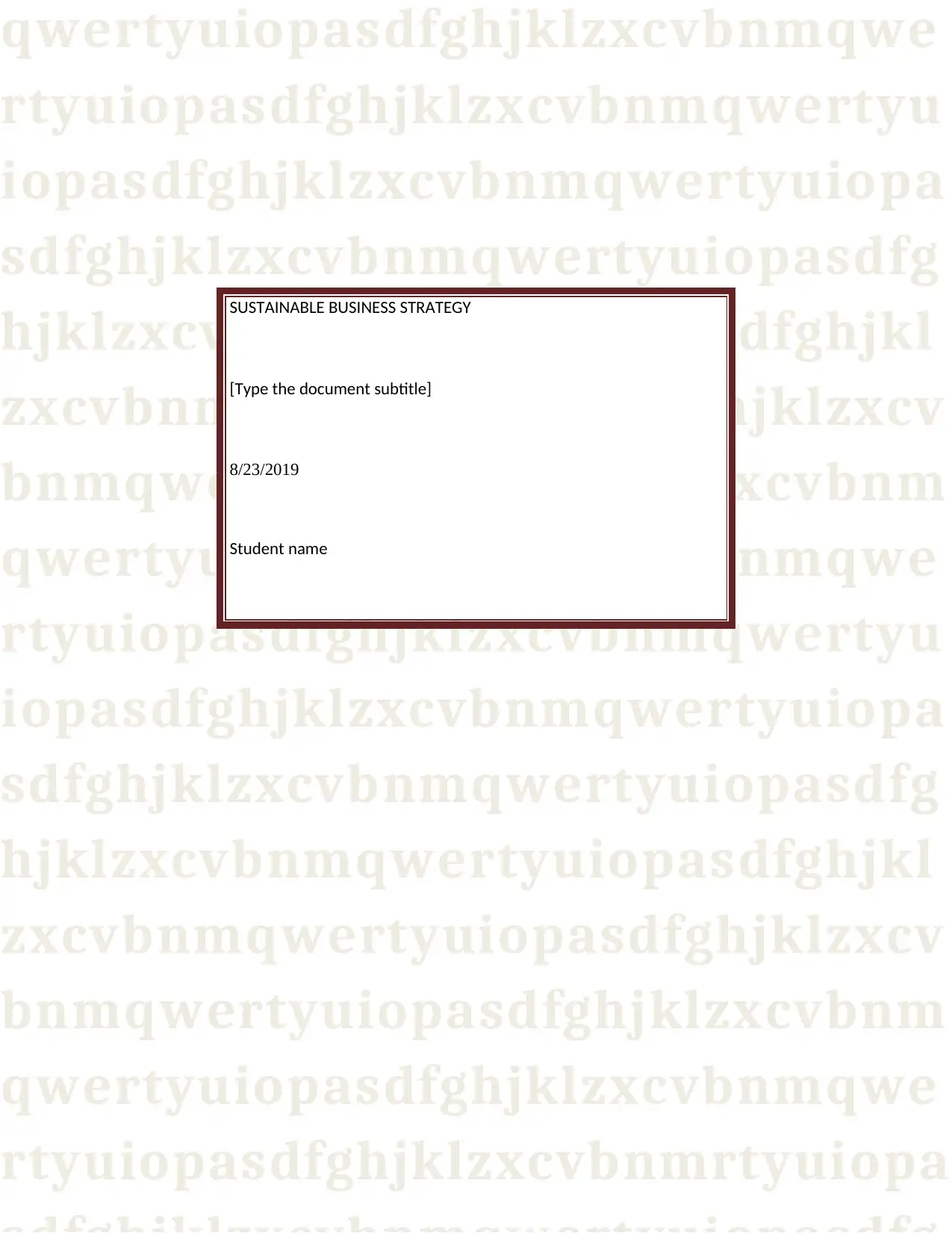
qwertyuiopasdfghjklzxcvbnmqwe
rtyuiopasdfghjklzxcvbnmqwertyu
iopasdfghjklzxcvbnmqwertyuiopa
sdfghjklzxcvbnmqwertyuiopasdfg
hjklzxcvbnmqwertyuiopasdfghjkl
zxcvbnmqwertyuiopasdfghjklzxcv
bnmqwertyuiopasdfghjklzxcvbnm
qwertyuiopasdfghjklzxcvbnmqwe
rtyuiopasdfghjklzxcvbnmqwertyu
iopasdfghjklzxcvbnmqwertyuiopa
sdfghjklzxcvbnmqwertyuiopasdfg
hjklzxcvbnmqwertyuiopasdfghjkl
zxcvbnmqwertyuiopasdfghjklzxcv
bnmqwertyuiopasdfghjklzxcvbnm
qwertyuiopasdfghjklzxcvbnmqwe
rtyuiopasdfghjklzxcvbnmrtyuiopa
SUSTAINABLE BUSINESS STRATEGY
[Type the document subtitle]
8/23/2019
Student name
rtyuiopasdfghjklzxcvbnmqwertyu
iopasdfghjklzxcvbnmqwertyuiopa
sdfghjklzxcvbnmqwertyuiopasdfg
hjklzxcvbnmqwertyuiopasdfghjkl
zxcvbnmqwertyuiopasdfghjklzxcv
bnmqwertyuiopasdfghjklzxcvbnm
qwertyuiopasdfghjklzxcvbnmqwe
rtyuiopasdfghjklzxcvbnmqwertyu
iopasdfghjklzxcvbnmqwertyuiopa
sdfghjklzxcvbnmqwertyuiopasdfg
hjklzxcvbnmqwertyuiopasdfghjkl
zxcvbnmqwertyuiopasdfghjklzxcv
bnmqwertyuiopasdfghjklzxcvbnm
qwertyuiopasdfghjklzxcvbnmqwe
rtyuiopasdfghjklzxcvbnmrtyuiopa
SUSTAINABLE BUSINESS STRATEGY
[Type the document subtitle]
8/23/2019
Student name
Secure Best Marks with AI Grader
Need help grading? Try our AI Grader for instant feedback on your assignments.
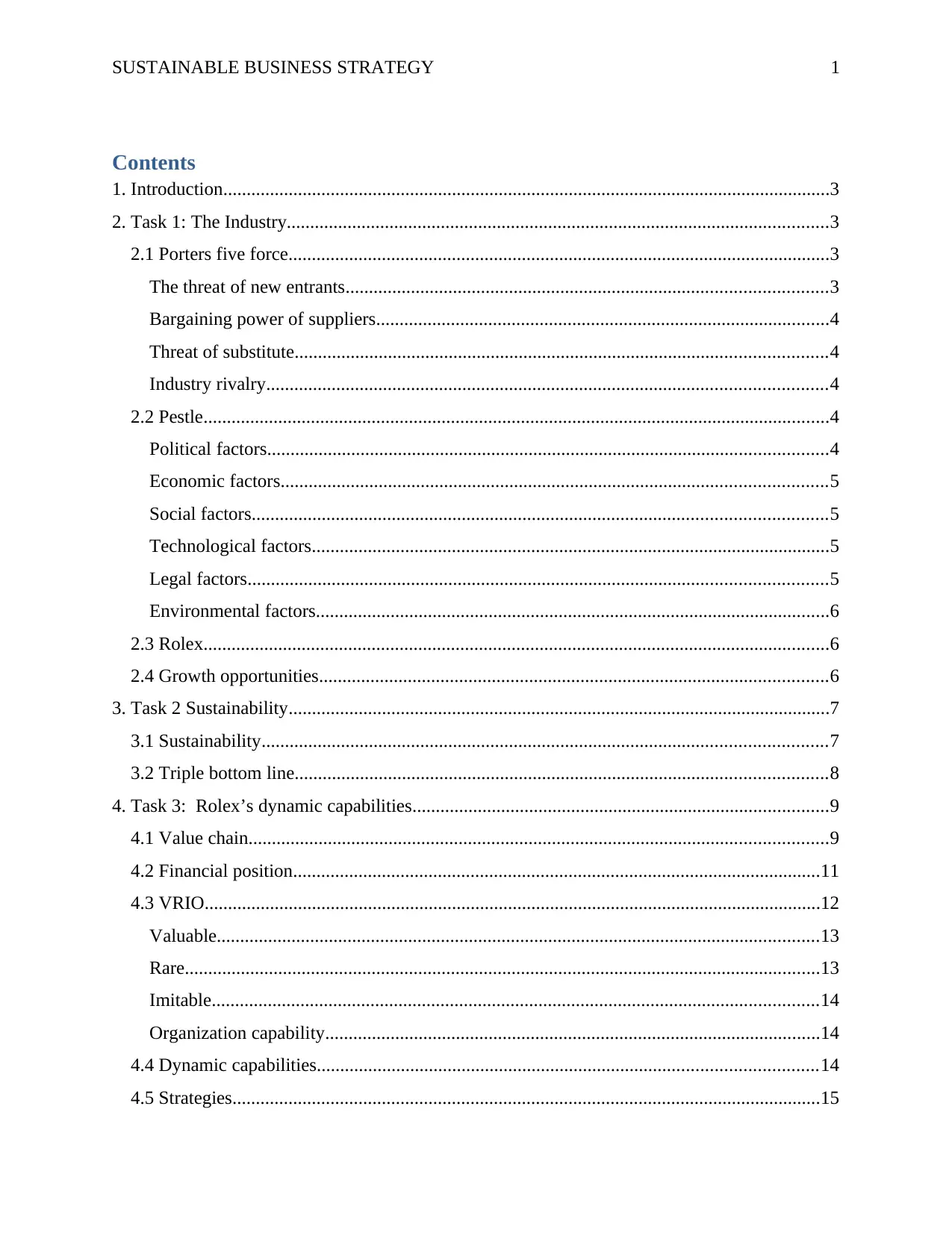
SUSTAINABLE BUSINESS STRATEGY 1
Contents
1. Introduction..................................................................................................................................3
2. Task 1: The Industry....................................................................................................................3
2.1 Porters five force....................................................................................................................3
The threat of new entrants.......................................................................................................3
Bargaining power of suppliers.................................................................................................4
Threat of substitute..................................................................................................................4
Industry rivalry........................................................................................................................4
2.2 Pestle......................................................................................................................................4
Political factors........................................................................................................................4
Economic factors.....................................................................................................................5
Social factors...........................................................................................................................5
Technological factors...............................................................................................................5
Legal factors............................................................................................................................5
Environmental factors..............................................................................................................6
2.3 Rolex......................................................................................................................................6
2.4 Growth opportunities.............................................................................................................6
3. Task 2 Sustainability....................................................................................................................7
3.1 Sustainability.........................................................................................................................7
3.2 Triple bottom line..................................................................................................................8
4. Task 3: Rolex’s dynamic capabilities.........................................................................................9
4.1 Value chain............................................................................................................................9
4.2 Financial position.................................................................................................................11
4.3 VRIO....................................................................................................................................12
Valuable.................................................................................................................................13
Rare........................................................................................................................................13
Imitable..................................................................................................................................14
Organization capability..........................................................................................................14
4.4 Dynamic capabilities...........................................................................................................14
4.5 Strategies..............................................................................................................................15
Contents
1. Introduction..................................................................................................................................3
2. Task 1: The Industry....................................................................................................................3
2.1 Porters five force....................................................................................................................3
The threat of new entrants.......................................................................................................3
Bargaining power of suppliers.................................................................................................4
Threat of substitute..................................................................................................................4
Industry rivalry........................................................................................................................4
2.2 Pestle......................................................................................................................................4
Political factors........................................................................................................................4
Economic factors.....................................................................................................................5
Social factors...........................................................................................................................5
Technological factors...............................................................................................................5
Legal factors............................................................................................................................5
Environmental factors..............................................................................................................6
2.3 Rolex......................................................................................................................................6
2.4 Growth opportunities.............................................................................................................6
3. Task 2 Sustainability....................................................................................................................7
3.1 Sustainability.........................................................................................................................7
3.2 Triple bottom line..................................................................................................................8
4. Task 3: Rolex’s dynamic capabilities.........................................................................................9
4.1 Value chain............................................................................................................................9
4.2 Financial position.................................................................................................................11
4.3 VRIO....................................................................................................................................12
Valuable.................................................................................................................................13
Rare........................................................................................................................................13
Imitable..................................................................................................................................14
Organization capability..........................................................................................................14
4.4 Dynamic capabilities...........................................................................................................14
4.5 Strategies..............................................................................................................................15
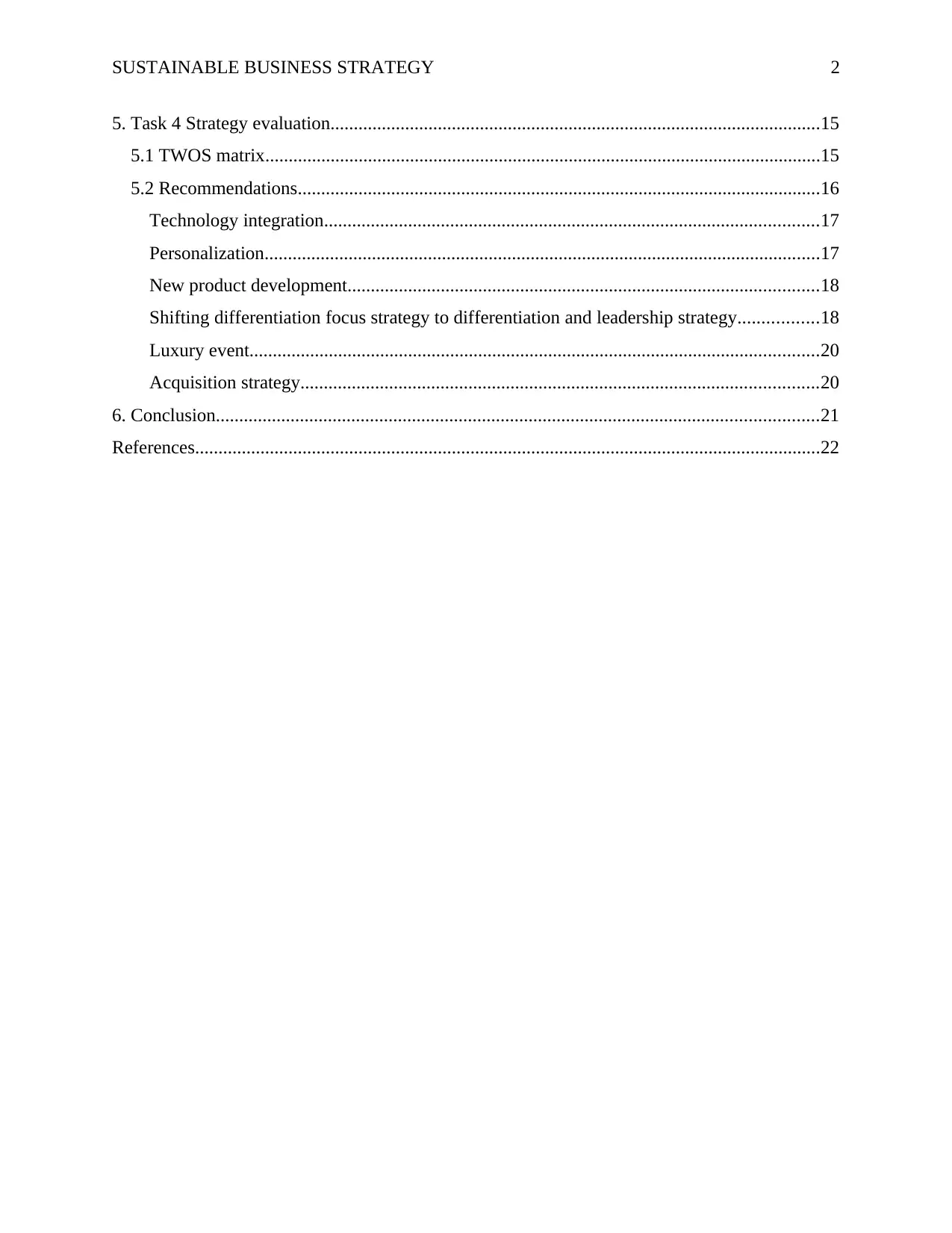
SUSTAINABLE BUSINESS STRATEGY 2
5. Task 4 Strategy evaluation.........................................................................................................15
5.1 TWOS matrix.......................................................................................................................15
5.2 Recommendations................................................................................................................16
Technology integration..........................................................................................................17
Personalization.......................................................................................................................17
New product development.....................................................................................................18
Shifting differentiation focus strategy to differentiation and leadership strategy.................18
Luxury event..........................................................................................................................20
Acquisition strategy...............................................................................................................20
6. Conclusion.................................................................................................................................21
References......................................................................................................................................22
5. Task 4 Strategy evaluation.........................................................................................................15
5.1 TWOS matrix.......................................................................................................................15
5.2 Recommendations................................................................................................................16
Technology integration..........................................................................................................17
Personalization.......................................................................................................................17
New product development.....................................................................................................18
Shifting differentiation focus strategy to differentiation and leadership strategy.................18
Luxury event..........................................................................................................................20
Acquisition strategy...............................................................................................................20
6. Conclusion.................................................................................................................................21
References......................................................................................................................................22
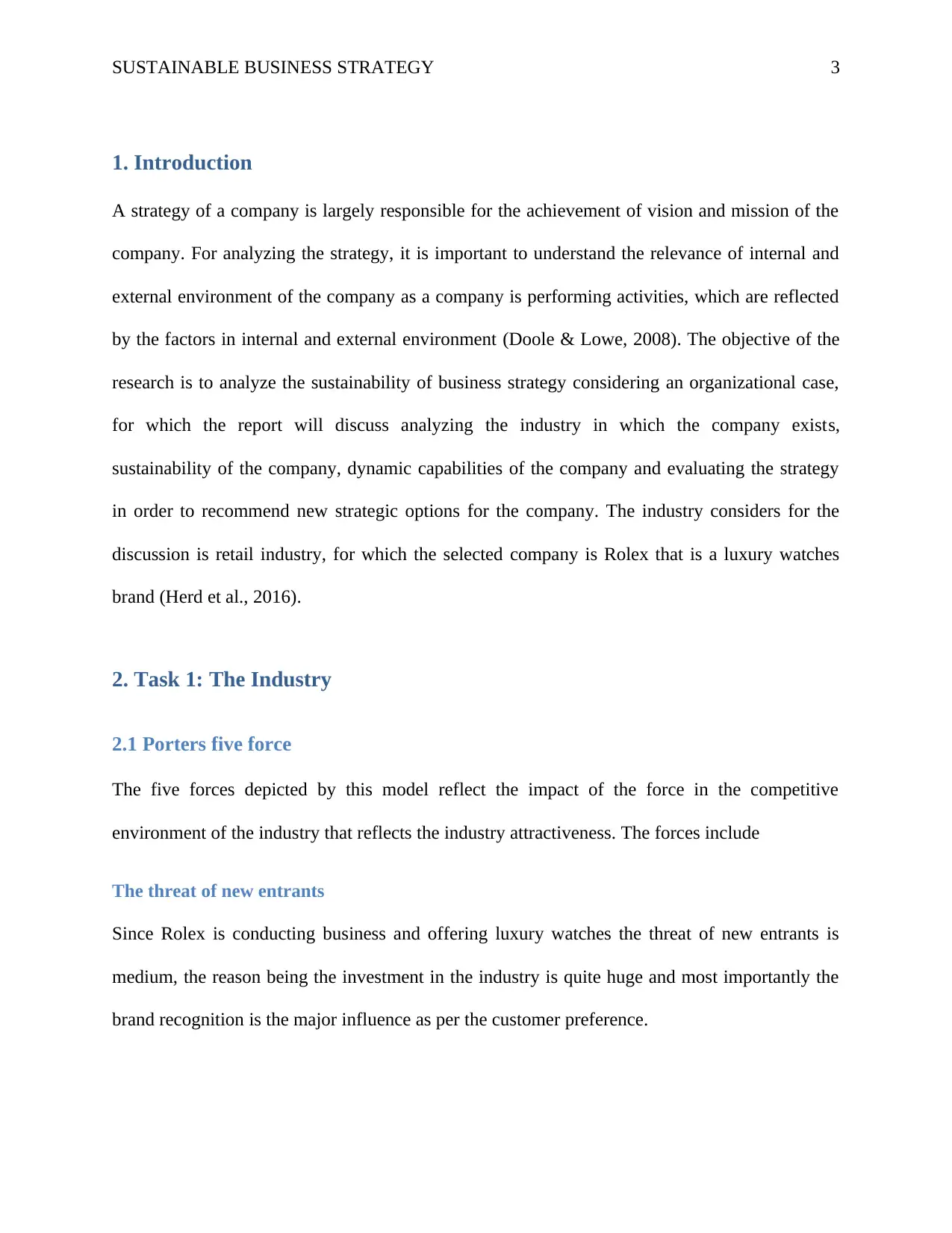
SUSTAINABLE BUSINESS STRATEGY 3
1. Introduction
A strategy of a company is largely responsible for the achievement of vision and mission of the
company. For analyzing the strategy, it is important to understand the relevance of internal and
external environment of the company as a company is performing activities, which are reflected
by the factors in internal and external environment (Doole & Lowe, 2008). The objective of the
research is to analyze the sustainability of business strategy considering an organizational case,
for which the report will discuss analyzing the industry in which the company exists,
sustainability of the company, dynamic capabilities of the company and evaluating the strategy
in order to recommend new strategic options for the company. The industry considers for the
discussion is retail industry, for which the selected company is Rolex that is a luxury watches
brand (Herd et al., 2016).
2. Task 1: The Industry
2.1 Porters five force
The five forces depicted by this model reflect the impact of the force in the competitive
environment of the industry that reflects the industry attractiveness. The forces include
The threat of new entrants
Since Rolex is conducting business and offering luxury watches the threat of new entrants is
medium, the reason being the investment in the industry is quite huge and most importantly the
brand recognition is the major influence as per the customer preference.
1. Introduction
A strategy of a company is largely responsible for the achievement of vision and mission of the
company. For analyzing the strategy, it is important to understand the relevance of internal and
external environment of the company as a company is performing activities, which are reflected
by the factors in internal and external environment (Doole & Lowe, 2008). The objective of the
research is to analyze the sustainability of business strategy considering an organizational case,
for which the report will discuss analyzing the industry in which the company exists,
sustainability of the company, dynamic capabilities of the company and evaluating the strategy
in order to recommend new strategic options for the company. The industry considers for the
discussion is retail industry, for which the selected company is Rolex that is a luxury watches
brand (Herd et al., 2016).
2. Task 1: The Industry
2.1 Porters five force
The five forces depicted by this model reflect the impact of the force in the competitive
environment of the industry that reflects the industry attractiveness. The forces include
The threat of new entrants
Since Rolex is conducting business and offering luxury watches the threat of new entrants is
medium, the reason being the investment in the industry is quite huge and most importantly the
brand recognition is the major influence as per the customer preference.
Secure Best Marks with AI Grader
Need help grading? Try our AI Grader for instant feedback on your assignments.
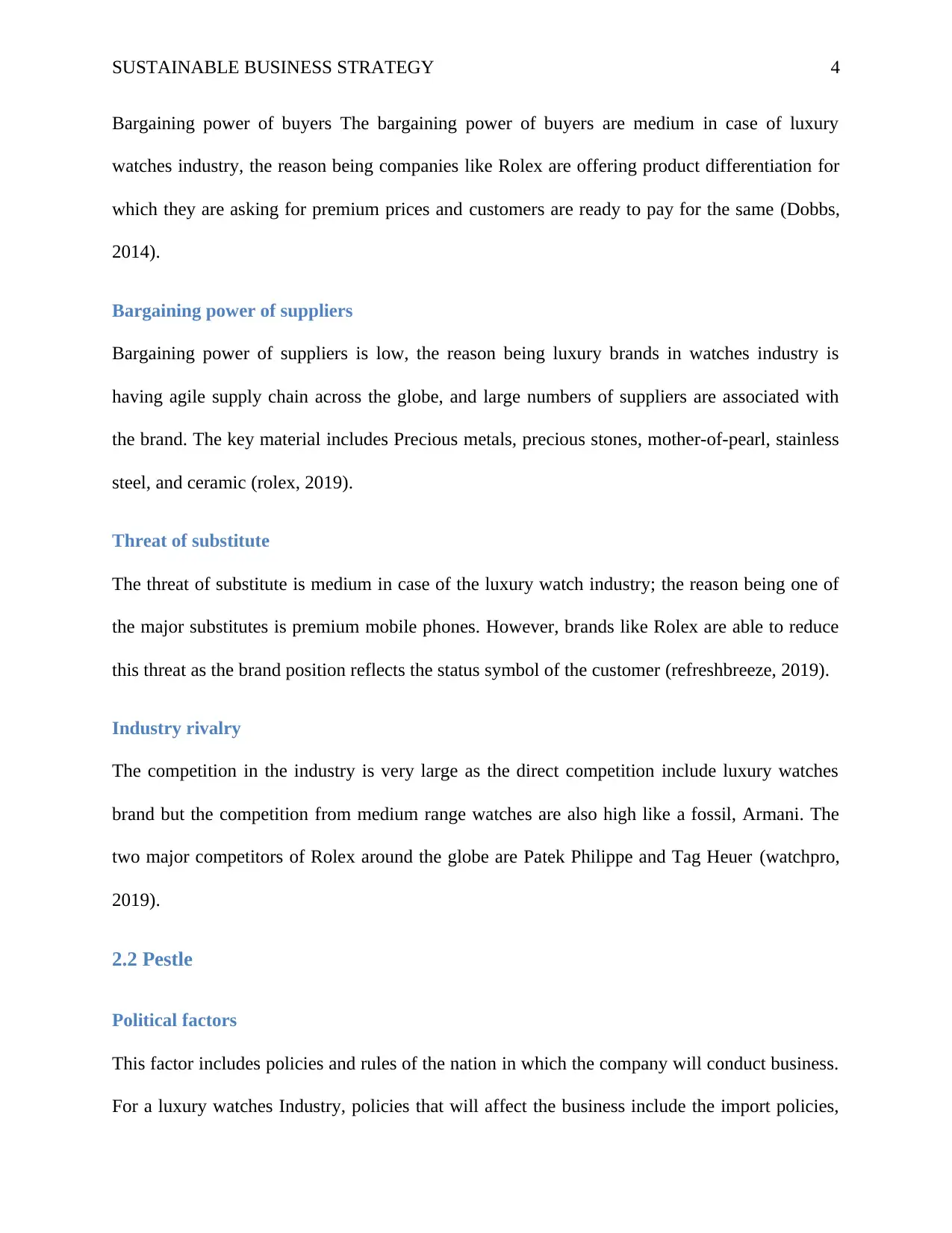
SUSTAINABLE BUSINESS STRATEGY 4
Bargaining power of buyers The bargaining power of buyers are medium in case of luxury
watches industry, the reason being companies like Rolex are offering product differentiation for
which they are asking for premium prices and customers are ready to pay for the same (Dobbs,
2014).
Bargaining power of suppliers
Bargaining power of suppliers is low, the reason being luxury brands in watches industry is
having agile supply chain across the globe, and large numbers of suppliers are associated with
the brand. The key material includes Precious metals, precious stones, mother-of-pearl, stainless
steel, and ceramic (rolex, 2019).
Threat of substitute
The threat of substitute is medium in case of the luxury watch industry; the reason being one of
the major substitutes is premium mobile phones. However, brands like Rolex are able to reduce
this threat as the brand position reflects the status symbol of the customer (refreshbreeze, 2019).
Industry rivalry
The competition in the industry is very large as the direct competition include luxury watches
brand but the competition from medium range watches are also high like a fossil, Armani. The
two major competitors of Rolex around the globe are Patek Philippe and Tag Heuer (watchpro,
2019).
2.2 Pestle
Political factors
This factor includes policies and rules of the nation in which the company will conduct business.
For a luxury watches Industry, policies that will affect the business include the import policies,
Bargaining power of buyers The bargaining power of buyers are medium in case of luxury
watches industry, the reason being companies like Rolex are offering product differentiation for
which they are asking for premium prices and customers are ready to pay for the same (Dobbs,
2014).
Bargaining power of suppliers
Bargaining power of suppliers is low, the reason being luxury brands in watches industry is
having agile supply chain across the globe, and large numbers of suppliers are associated with
the brand. The key material includes Precious metals, precious stones, mother-of-pearl, stainless
steel, and ceramic (rolex, 2019).
Threat of substitute
The threat of substitute is medium in case of the luxury watch industry; the reason being one of
the major substitutes is premium mobile phones. However, brands like Rolex are able to reduce
this threat as the brand position reflects the status symbol of the customer (refreshbreeze, 2019).
Industry rivalry
The competition in the industry is very large as the direct competition include luxury watches
brand but the competition from medium range watches are also high like a fossil, Armani. The
two major competitors of Rolex around the globe are Patek Philippe and Tag Heuer (watchpro,
2019).
2.2 Pestle
Political factors
This factor includes policies and rules of the nation in which the company will conduct business.
For a luxury watches Industry, policies that will affect the business include the import policies,
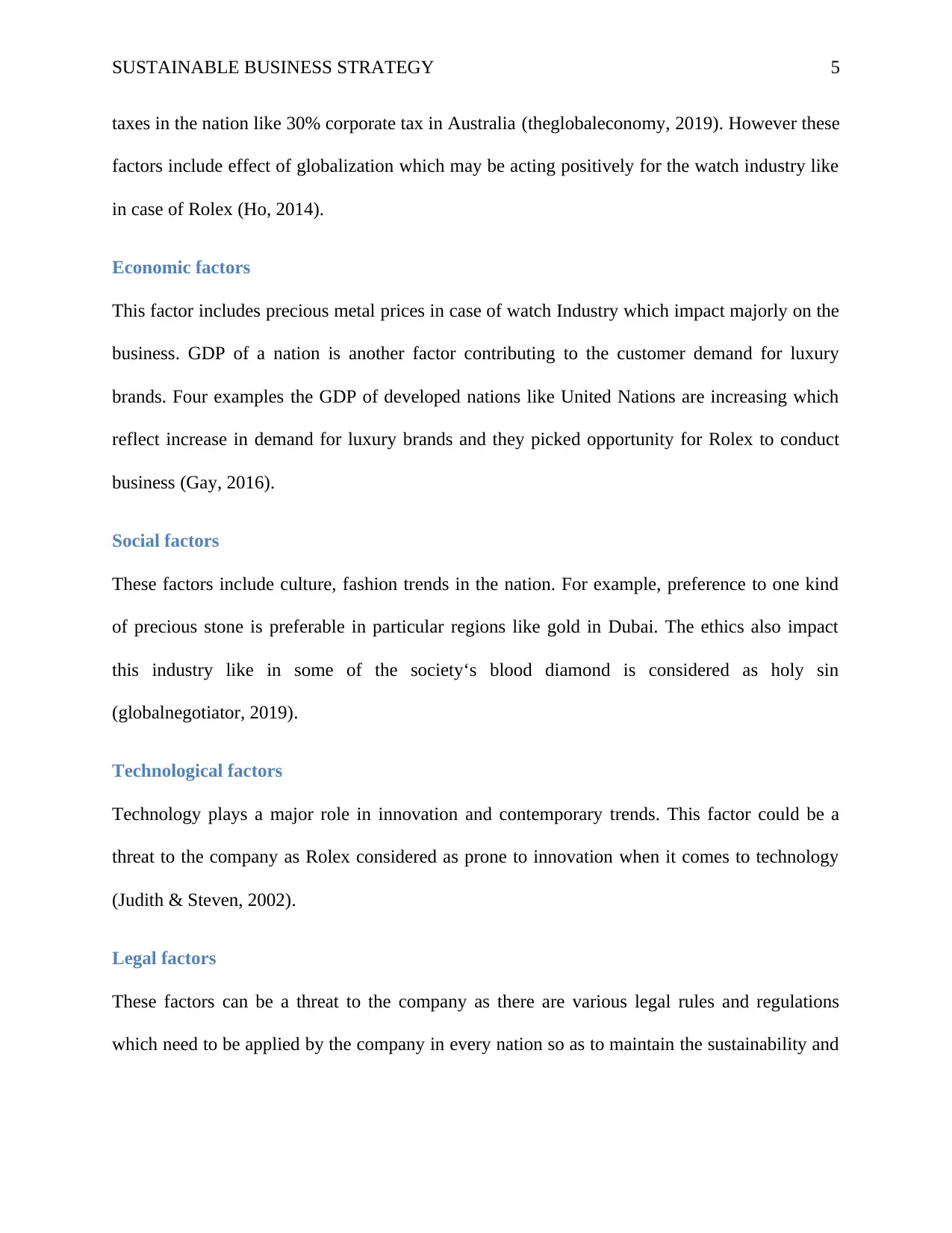
SUSTAINABLE BUSINESS STRATEGY 5
taxes in the nation like 30% corporate tax in Australia (theglobaleconomy, 2019). However these
factors include effect of globalization which may be acting positively for the watch industry like
in case of Rolex (Ho, 2014).
Economic factors
This factor includes precious metal prices in case of watch Industry which impact majorly on the
business. GDP of a nation is another factor contributing to the customer demand for luxury
brands. Four examples the GDP of developed nations like United Nations are increasing which
reflect increase in demand for luxury brands and they picked opportunity for Rolex to conduct
business (Gay, 2016).
Social factors
These factors include culture, fashion trends in the nation. For example, preference to one kind
of precious stone is preferable in particular regions like gold in Dubai. The ethics also impact
this industry like in some of the society‘s blood diamond is considered as holy sin
(globalnegotiator, 2019).
Technological factors
Technology plays a major role in innovation and contemporary trends. This factor could be a
threat to the company as Rolex considered as prone to innovation when it comes to technology
(Judith & Steven, 2002).
Legal factors
These factors can be a threat to the company as there are various legal rules and regulations
which need to be applied by the company in every nation so as to maintain the sustainability and
taxes in the nation like 30% corporate tax in Australia (theglobaleconomy, 2019). However these
factors include effect of globalization which may be acting positively for the watch industry like
in case of Rolex (Ho, 2014).
Economic factors
This factor includes precious metal prices in case of watch Industry which impact majorly on the
business. GDP of a nation is another factor contributing to the customer demand for luxury
brands. Four examples the GDP of developed nations like United Nations are increasing which
reflect increase in demand for luxury brands and they picked opportunity for Rolex to conduct
business (Gay, 2016).
Social factors
These factors include culture, fashion trends in the nation. For example, preference to one kind
of precious stone is preferable in particular regions like gold in Dubai. The ethics also impact
this industry like in some of the society‘s blood diamond is considered as holy sin
(globalnegotiator, 2019).
Technological factors
Technology plays a major role in innovation and contemporary trends. This factor could be a
threat to the company as Rolex considered as prone to innovation when it comes to technology
(Judith & Steven, 2002).
Legal factors
These factors can be a threat to the company as there are various legal rules and regulations
which need to be applied by the company in every nation so as to maintain the sustainability and
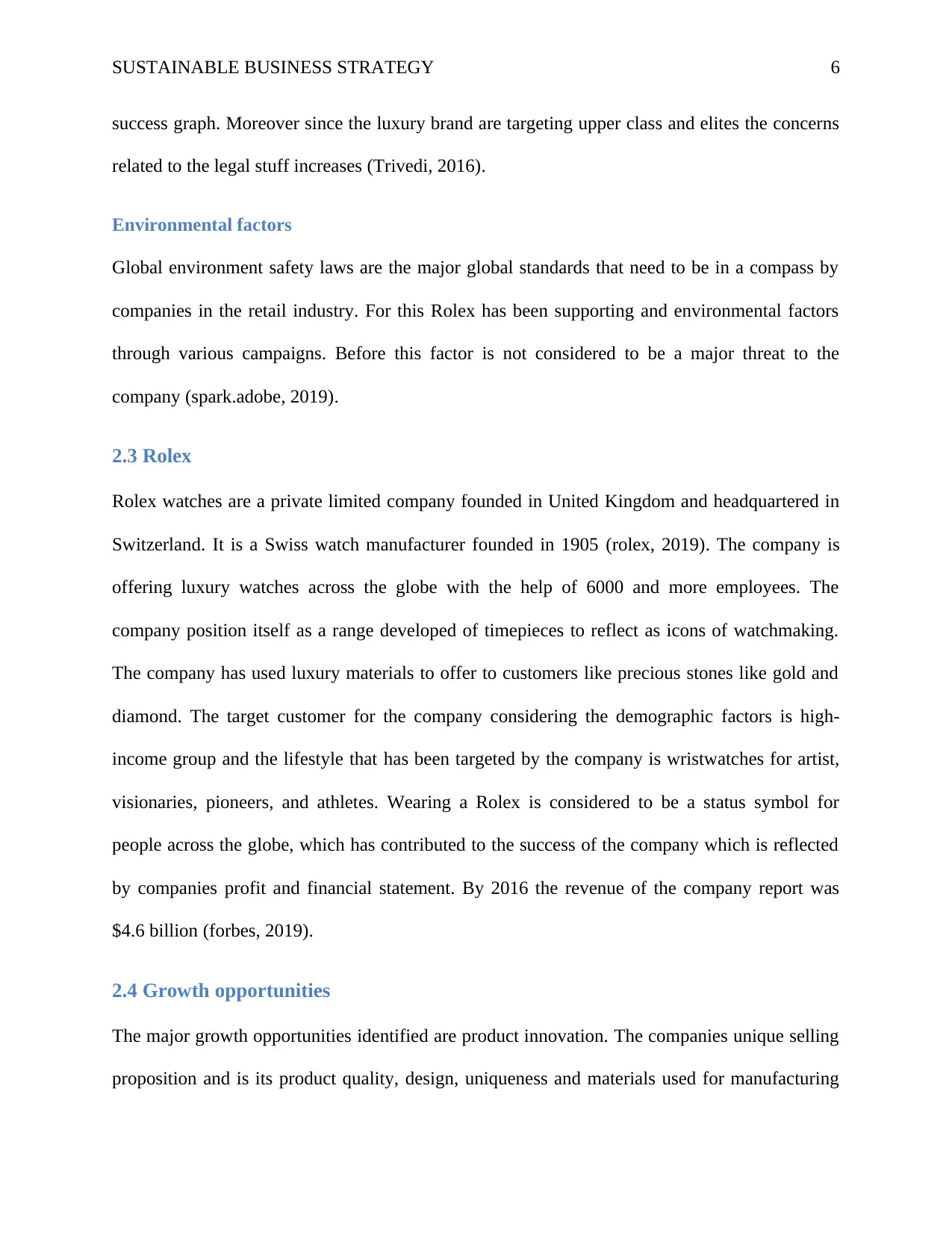
SUSTAINABLE BUSINESS STRATEGY 6
success graph. Moreover since the luxury brand are targeting upper class and elites the concerns
related to the legal stuff increases (Trivedi, 2016).
Environmental factors
Global environment safety laws are the major global standards that need to be in a compass by
companies in the retail industry. For this Rolex has been supporting and environmental factors
through various campaigns. Before this factor is not considered to be a major threat to the
company (spark.adobe, 2019).
2.3 Rolex
Rolex watches are a private limited company founded in United Kingdom and headquartered in
Switzerland. It is a Swiss watch manufacturer founded in 1905 (rolex, 2019). The company is
offering luxury watches across the globe with the help of 6000 and more employees. The
company position itself as a range developed of timepieces to reflect as icons of watchmaking.
The company has used luxury materials to offer to customers like precious stones like gold and
diamond. The target customer for the company considering the demographic factors is high-
income group and the lifestyle that has been targeted by the company is wristwatches for artist,
visionaries, pioneers, and athletes. Wearing a Rolex is considered to be a status symbol for
people across the globe, which has contributed to the success of the company which is reflected
by companies profit and financial statement. By 2016 the revenue of the company report was
$4.6 billion (forbes, 2019).
2.4 Growth opportunities
The major growth opportunities identified are product innovation. The companies unique selling
proposition and is its product quality, design, uniqueness and materials used for manufacturing
success graph. Moreover since the luxury brand are targeting upper class and elites the concerns
related to the legal stuff increases (Trivedi, 2016).
Environmental factors
Global environment safety laws are the major global standards that need to be in a compass by
companies in the retail industry. For this Rolex has been supporting and environmental factors
through various campaigns. Before this factor is not considered to be a major threat to the
company (spark.adobe, 2019).
2.3 Rolex
Rolex watches are a private limited company founded in United Kingdom and headquartered in
Switzerland. It is a Swiss watch manufacturer founded in 1905 (rolex, 2019). The company is
offering luxury watches across the globe with the help of 6000 and more employees. The
company position itself as a range developed of timepieces to reflect as icons of watchmaking.
The company has used luxury materials to offer to customers like precious stones like gold and
diamond. The target customer for the company considering the demographic factors is high-
income group and the lifestyle that has been targeted by the company is wristwatches for artist,
visionaries, pioneers, and athletes. Wearing a Rolex is considered to be a status symbol for
people across the globe, which has contributed to the success of the company which is reflected
by companies profit and financial statement. By 2016 the revenue of the company report was
$4.6 billion (forbes, 2019).
2.4 Growth opportunities
The major growth opportunities identified are product innovation. The companies unique selling
proposition and is its product quality, design, uniqueness and materials used for manufacturing
Paraphrase This Document
Need a fresh take? Get an instant paraphrase of this document with our AI Paraphraser
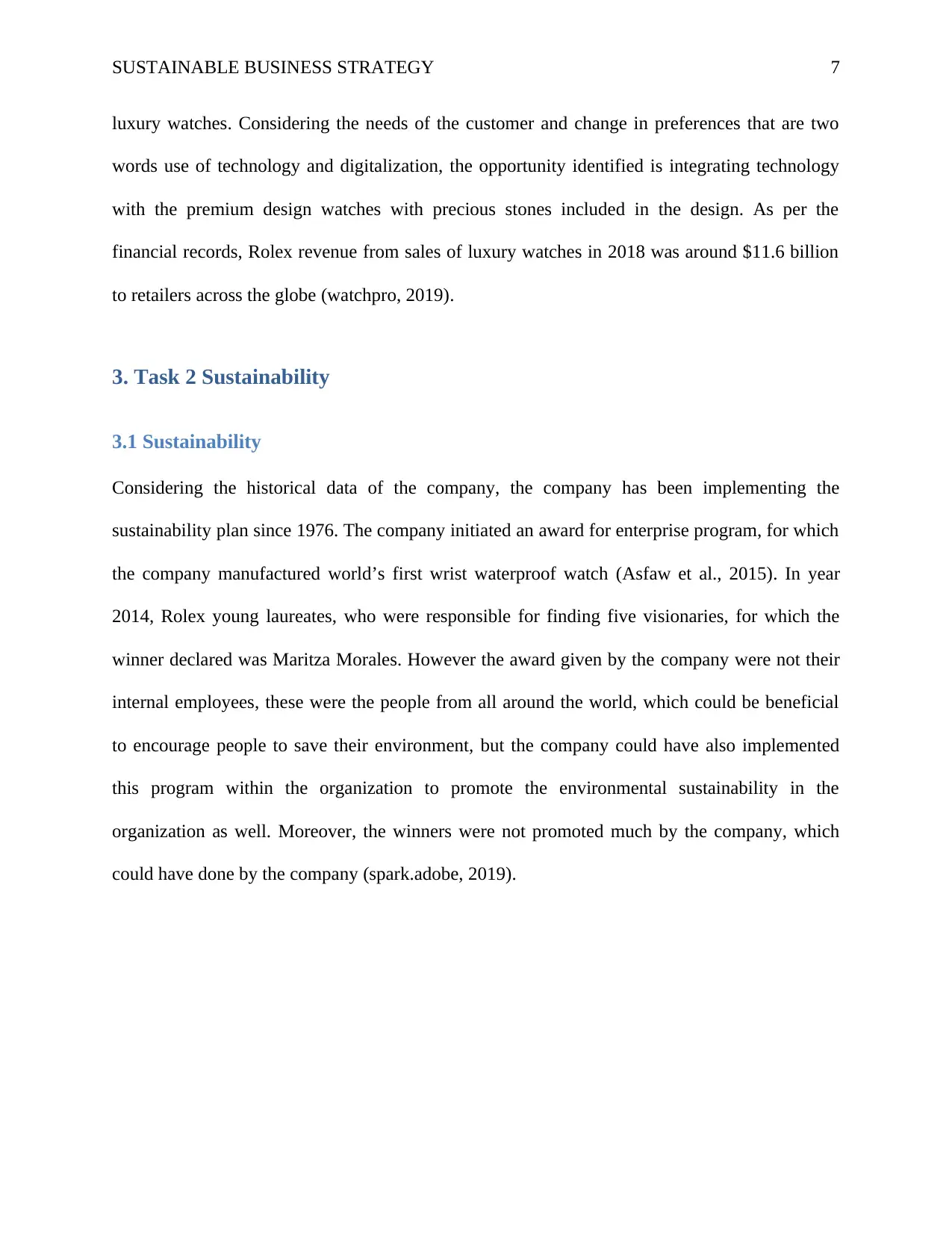
SUSTAINABLE BUSINESS STRATEGY 7
luxury watches. Considering the needs of the customer and change in preferences that are two
words use of technology and digitalization, the opportunity identified is integrating technology
with the premium design watches with precious stones included in the design. As per the
financial records, Rolex revenue from sales of luxury watches in 2018 was around $11.6 billion
to retailers across the globe (watchpro, 2019).
3. Task 2 Sustainability
3.1 Sustainability
Considering the historical data of the company, the company has been implementing the
sustainability plan since 1976. The company initiated an award for enterprise program, for which
the company manufactured world’s first wrist waterproof watch (Asfaw et al., 2015). In year
2014, Rolex young laureates, who were responsible for finding five visionaries, for which the
winner declared was Maritza Morales. However the award given by the company were not their
internal employees, these were the people from all around the world, which could be beneficial
to encourage people to save their environment, but the company could have also implemented
this program within the organization to promote the environmental sustainability in the
organization as well. Moreover, the winners were not promoted much by the company, which
could have done by the company (spark.adobe, 2019).
luxury watches. Considering the needs of the customer and change in preferences that are two
words use of technology and digitalization, the opportunity identified is integrating technology
with the premium design watches with precious stones included in the design. As per the
financial records, Rolex revenue from sales of luxury watches in 2018 was around $11.6 billion
to retailers across the globe (watchpro, 2019).
3. Task 2 Sustainability
3.1 Sustainability
Considering the historical data of the company, the company has been implementing the
sustainability plan since 1976. The company initiated an award for enterprise program, for which
the company manufactured world’s first wrist waterproof watch (Asfaw et al., 2015). In year
2014, Rolex young laureates, who were responsible for finding five visionaries, for which the
winner declared was Maritza Morales. However the award given by the company were not their
internal employees, these were the people from all around the world, which could be beneficial
to encourage people to save their environment, but the company could have also implemented
this program within the organization to promote the environmental sustainability in the
organization as well. Moreover, the winners were not promoted much by the company, which
could have done by the company (spark.adobe, 2019).
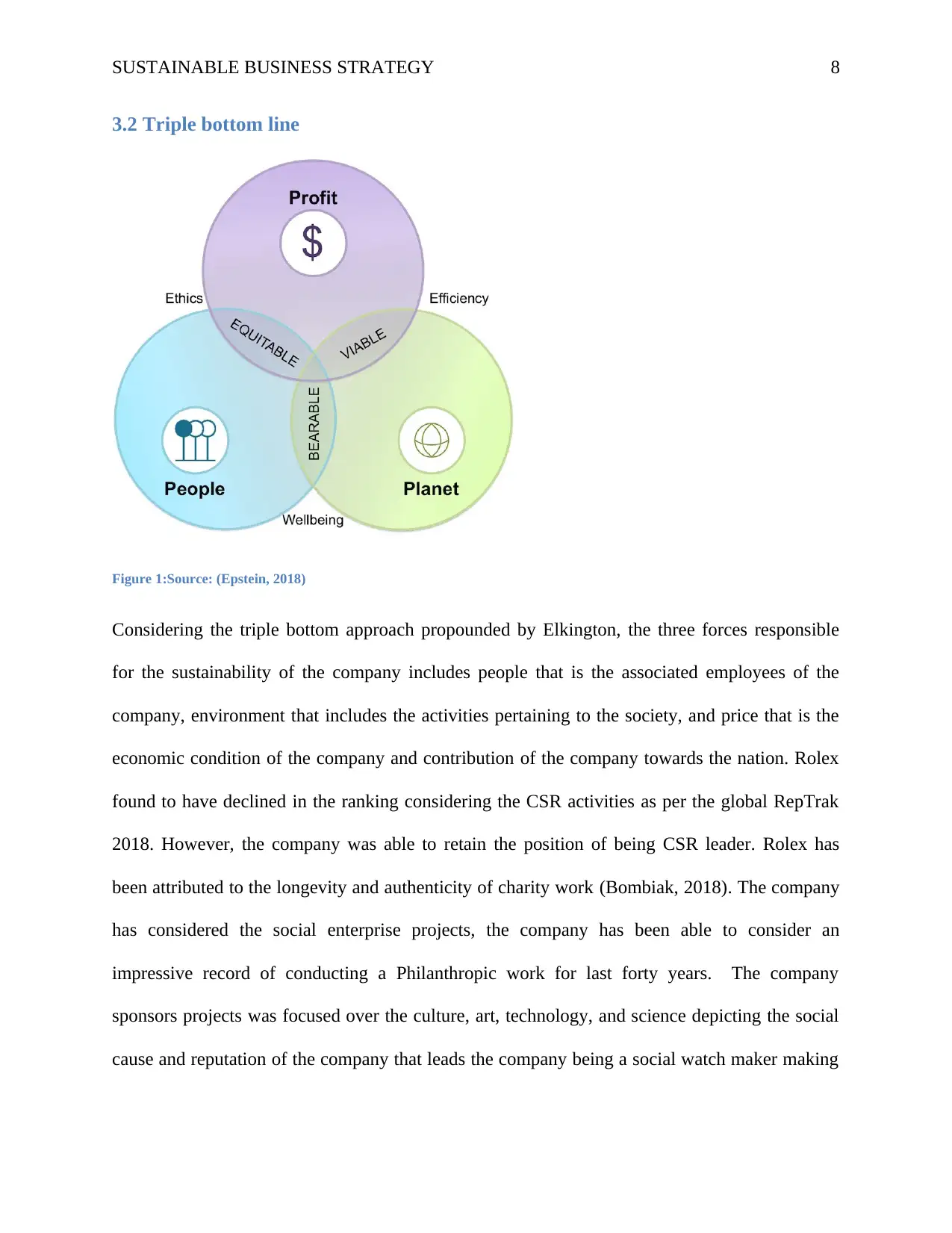
SUSTAINABLE BUSINESS STRATEGY 8
3.2 Triple bottom line
Figure 1:Source: (Epstein, 2018)
Considering the triple bottom approach propounded by Elkington, the three forces responsible
for the sustainability of the company includes people that is the associated employees of the
company, environment that includes the activities pertaining to the society, and price that is the
economic condition of the company and contribution of the company towards the nation. Rolex
found to have declined in the ranking considering the CSR activities as per the global RepTrak
2018. However, the company was able to retain the position of being CSR leader. Rolex has
been attributed to the longevity and authenticity of charity work (Bombiak, 2018). The company
has considered the social enterprise projects, the company has been able to consider an
impressive record of conducting a Philanthropic work for last forty years. The company
sponsors projects was focused over the culture, art, technology, and science depicting the social
cause and reputation of the company that leads the company being a social watch maker making
3.2 Triple bottom line
Figure 1:Source: (Epstein, 2018)
Considering the triple bottom approach propounded by Elkington, the three forces responsible
for the sustainability of the company includes people that is the associated employees of the
company, environment that includes the activities pertaining to the society, and price that is the
economic condition of the company and contribution of the company towards the nation. Rolex
found to have declined in the ranking considering the CSR activities as per the global RepTrak
2018. However, the company was able to retain the position of being CSR leader. Rolex has
been attributed to the longevity and authenticity of charity work (Bombiak, 2018). The company
has considered the social enterprise projects, the company has been able to consider an
impressive record of conducting a Philanthropic work for last forty years. The company
sponsors projects was focused over the culture, art, technology, and science depicting the social
cause and reputation of the company that leads the company being a social watch maker making
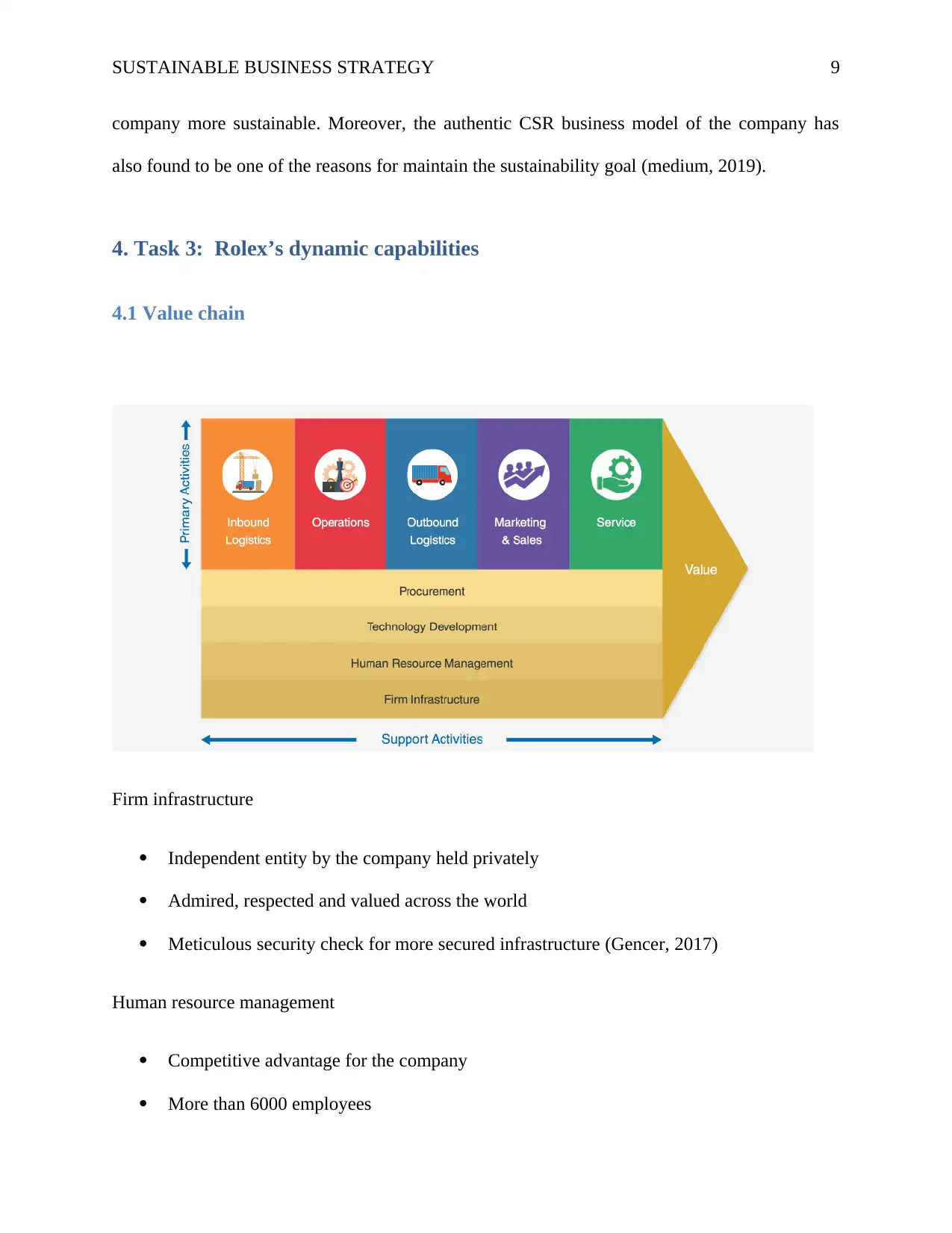
SUSTAINABLE BUSINESS STRATEGY 9
company more sustainable. Moreover, the authentic CSR business model of the company has
also found to be one of the reasons for maintain the sustainability goal (medium, 2019).
4. Task 3: Rolex’s dynamic capabilities
4.1 Value chain
Firm infrastructure
Independent entity by the company held privately
Admired, respected and valued across the world
Meticulous security check for more secured infrastructure (Gencer, 2017)
Human resource management
Competitive advantage for the company
More than 6000 employees
company more sustainable. Moreover, the authentic CSR business model of the company has
also found to be one of the reasons for maintain the sustainability goal (medium, 2019).
4. Task 3: Rolex’s dynamic capabilities
4.1 Value chain
Firm infrastructure
Independent entity by the company held privately
Admired, respected and valued across the world
Meticulous security check for more secured infrastructure (Gencer, 2017)
Human resource management
Competitive advantage for the company
More than 6000 employees
Secure Best Marks with AI Grader
Need help grading? Try our AI Grader for instant feedback on your assignments.
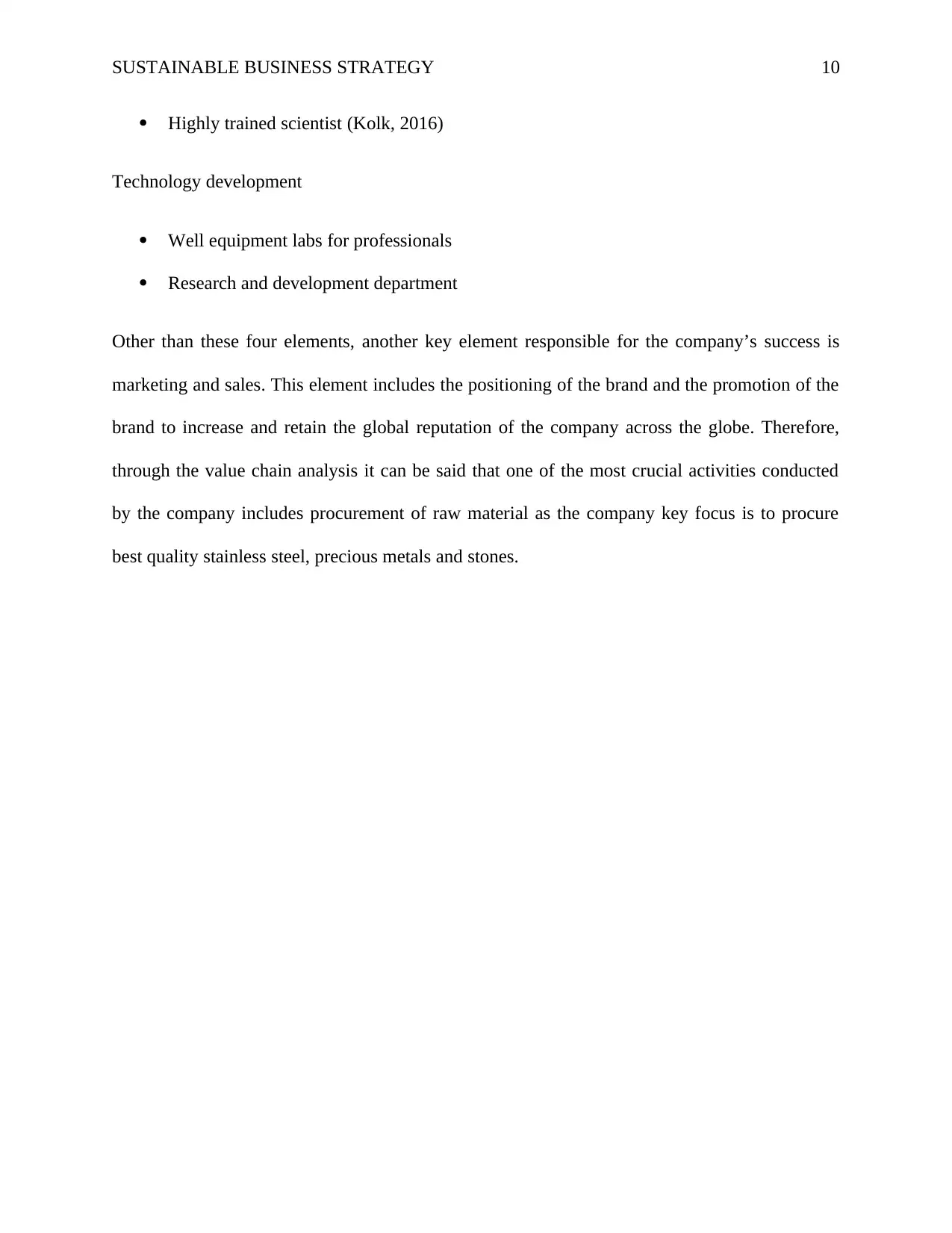
SUSTAINABLE BUSINESS STRATEGY 10
Highly trained scientist (Kolk, 2016)
Technology development
Well equipment labs for professionals
Research and development department
Other than these four elements, another key element responsible for the company’s success is
marketing and sales. This element includes the positioning of the brand and the promotion of the
brand to increase and retain the global reputation of the company across the globe. Therefore,
through the value chain analysis it can be said that one of the most crucial activities conducted
by the company includes procurement of raw material as the company key focus is to procure
best quality stainless steel, precious metals and stones.
Highly trained scientist (Kolk, 2016)
Technology development
Well equipment labs for professionals
Research and development department
Other than these four elements, another key element responsible for the company’s success is
marketing and sales. This element includes the positioning of the brand and the promotion of the
brand to increase and retain the global reputation of the company across the globe. Therefore,
through the value chain analysis it can be said that one of the most crucial activities conducted
by the company includes procurement of raw material as the company key focus is to procure
best quality stainless steel, precious metals and stones.
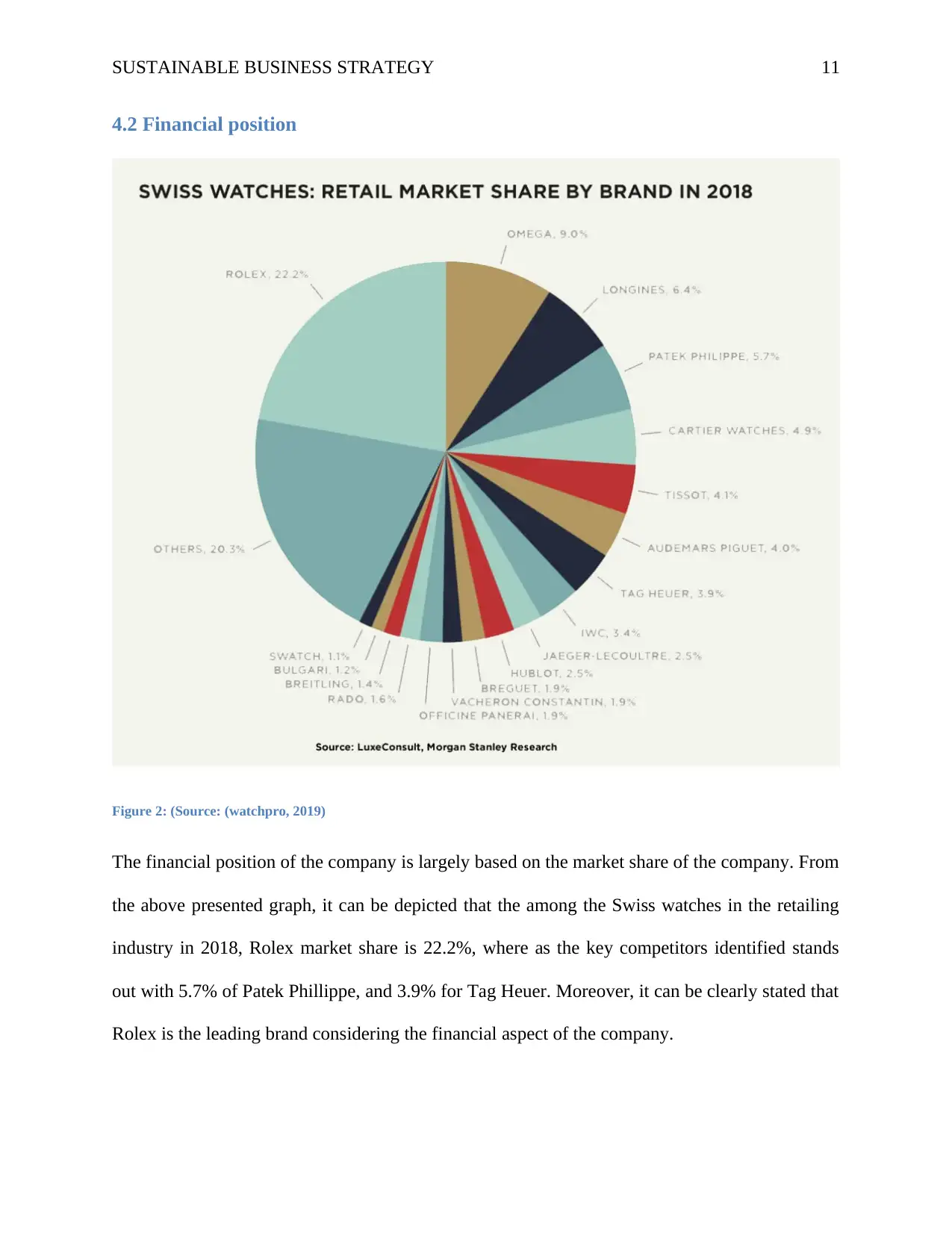
SUSTAINABLE BUSINESS STRATEGY 11
4.2 Financial position
Figure 2: (Source: (watchpro, 2019)
The financial position of the company is largely based on the market share of the company. From
the above presented graph, it can be depicted that the among the Swiss watches in the retailing
industry in 2018, Rolex market share is 22.2%, where as the key competitors identified stands
out with 5.7% of Patek Phillippe, and 3.9% for Tag Heuer. Moreover, it can be clearly stated that
Rolex is the leading brand considering the financial aspect of the company.
4.2 Financial position
Figure 2: (Source: (watchpro, 2019)
The financial position of the company is largely based on the market share of the company. From
the above presented graph, it can be depicted that the among the Swiss watches in the retailing
industry in 2018, Rolex market share is 22.2%, where as the key competitors identified stands
out with 5.7% of Patek Phillippe, and 3.9% for Tag Heuer. Moreover, it can be clearly stated that
Rolex is the leading brand considering the financial aspect of the company.
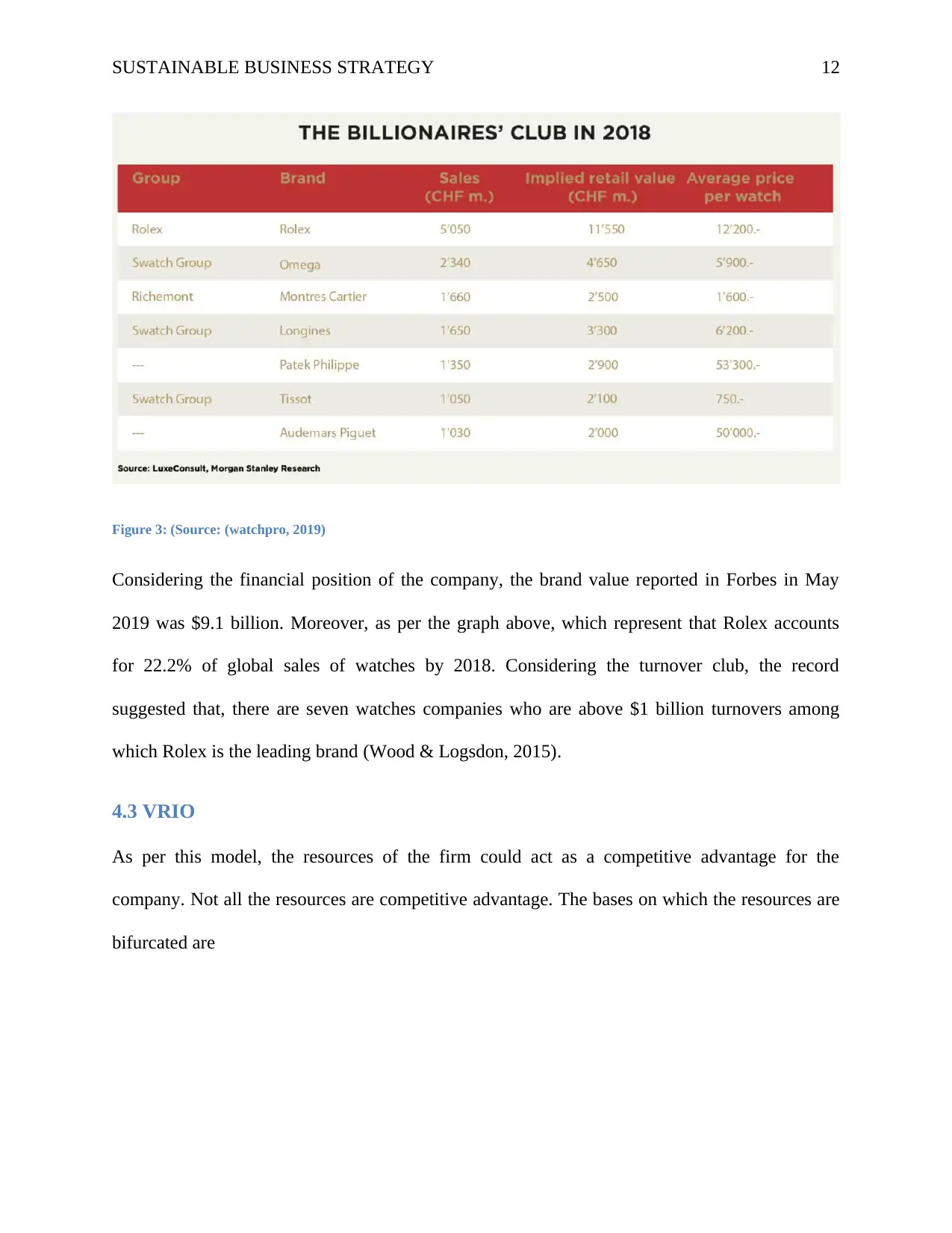
SUSTAINABLE BUSINESS STRATEGY 12
Figure 3: (Source: (watchpro, 2019)
Considering the financial position of the company, the brand value reported in Forbes in May
2019 was $9.1 billion. Moreover, as per the graph above, which represent that Rolex accounts
for 22.2% of global sales of watches by 2018. Considering the turnover club, the record
suggested that, there are seven watches companies who are above $1 billion turnovers among
which Rolex is the leading brand (Wood & Logsdon, 2015).
4.3 VRIO
As per this model, the resources of the firm could act as a competitive advantage for the
company. Not all the resources are competitive advantage. The bases on which the resources are
bifurcated are
Figure 3: (Source: (watchpro, 2019)
Considering the financial position of the company, the brand value reported in Forbes in May
2019 was $9.1 billion. Moreover, as per the graph above, which represent that Rolex accounts
for 22.2% of global sales of watches by 2018. Considering the turnover club, the record
suggested that, there are seven watches companies who are above $1 billion turnovers among
which Rolex is the leading brand (Wood & Logsdon, 2015).
4.3 VRIO
As per this model, the resources of the firm could act as a competitive advantage for the
company. Not all the resources are competitive advantage. The bases on which the resources are
bifurcated are
Paraphrase This Document
Need a fresh take? Get an instant paraphrase of this document with our AI Paraphraser
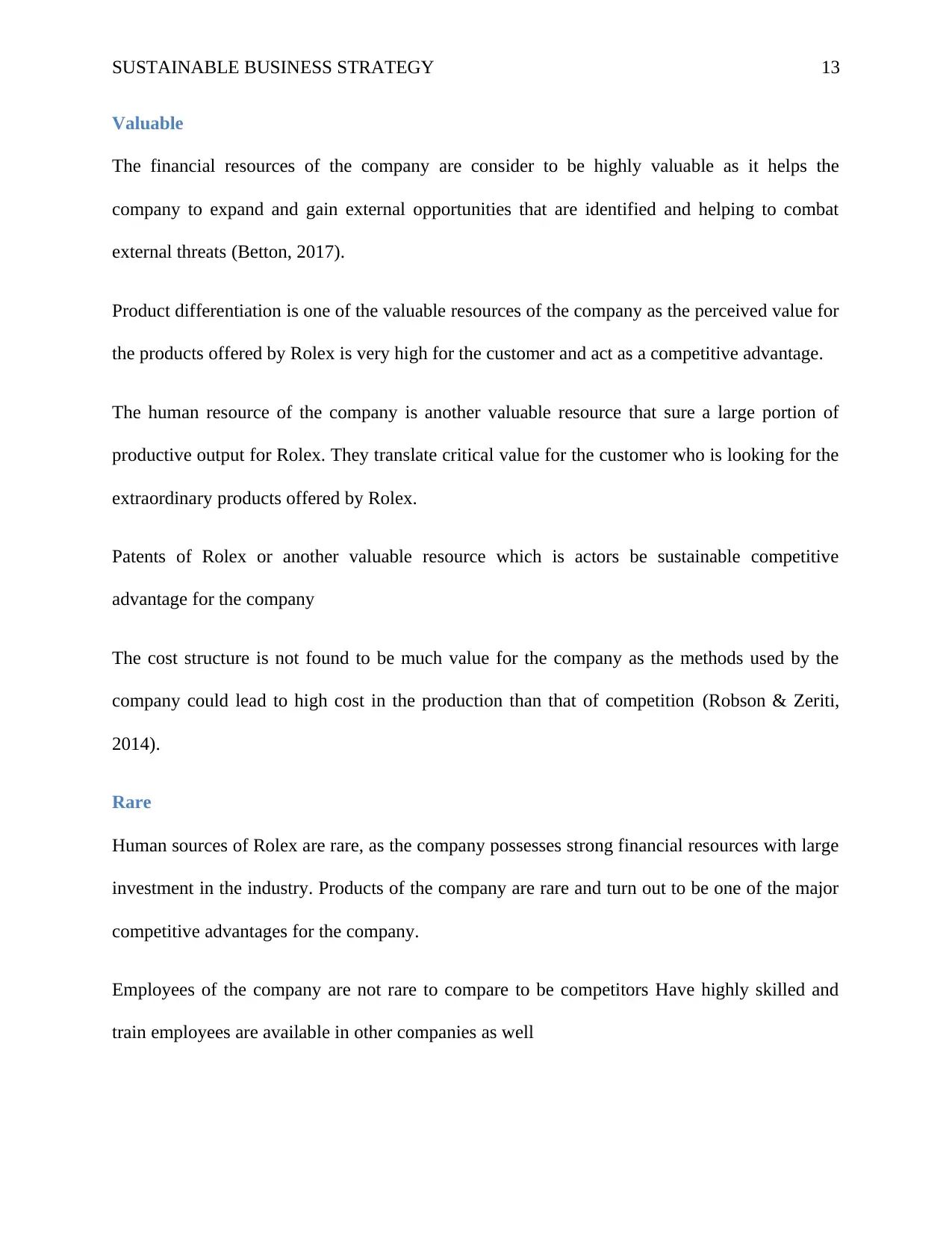
SUSTAINABLE BUSINESS STRATEGY 13
Valuable
The financial resources of the company are consider to be highly valuable as it helps the
company to expand and gain external opportunities that are identified and helping to combat
external threats (Betton, 2017).
Product differentiation is one of the valuable resources of the company as the perceived value for
the products offered by Rolex is very high for the customer and act as a competitive advantage.
The human resource of the company is another valuable resource that sure a large portion of
productive output for Rolex. They translate critical value for the customer who is looking for the
extraordinary products offered by Rolex.
Patents of Rolex or another valuable resource which is actors be sustainable competitive
advantage for the company
The cost structure is not found to be much value for the company as the methods used by the
company could lead to high cost in the production than that of competition (Robson & Zeriti,
2014).
Rare
Human sources of Rolex are rare, as the company possesses strong financial resources with large
investment in the industry. Products of the company are rare and turn out to be one of the major
competitive advantages for the company.
Employees of the company are not rare to compare to be competitors Have highly skilled and
train employees are available in other companies as well
Valuable
The financial resources of the company are consider to be highly valuable as it helps the
company to expand and gain external opportunities that are identified and helping to combat
external threats (Betton, 2017).
Product differentiation is one of the valuable resources of the company as the perceived value for
the products offered by Rolex is very high for the customer and act as a competitive advantage.
The human resource of the company is another valuable resource that sure a large portion of
productive output for Rolex. They translate critical value for the customer who is looking for the
extraordinary products offered by Rolex.
Patents of Rolex or another valuable resource which is actors be sustainable competitive
advantage for the company
The cost structure is not found to be much value for the company as the methods used by the
company could lead to high cost in the production than that of competition (Robson & Zeriti,
2014).
Rare
Human sources of Rolex are rare, as the company possesses strong financial resources with large
investment in the industry. Products of the company are rare and turn out to be one of the major
competitive advantages for the company.
Employees of the company are not rare to compare to be competitors Have highly skilled and
train employees are available in other companies as well
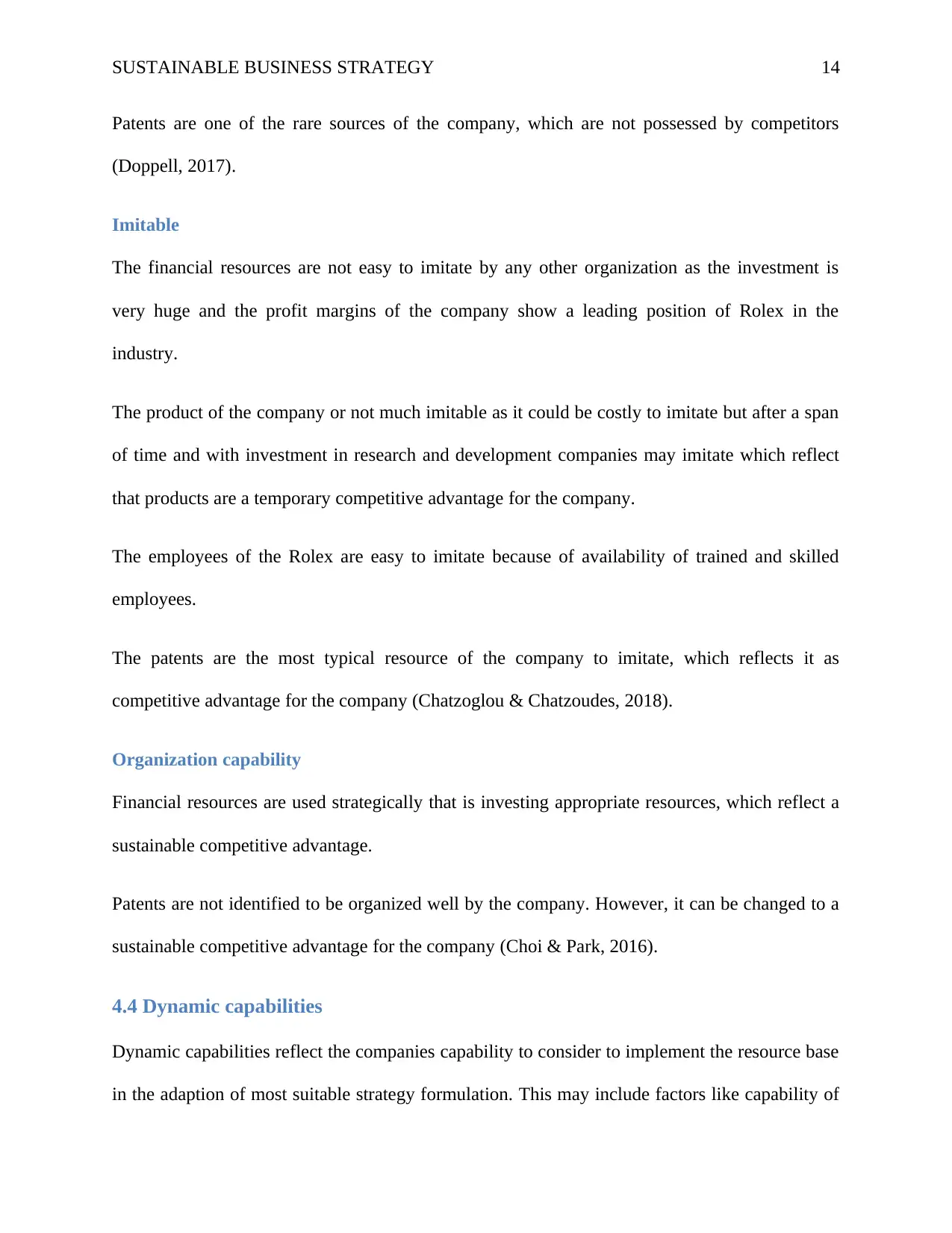
SUSTAINABLE BUSINESS STRATEGY 14
Patents are one of the rare sources of the company, which are not possessed by competitors
(Doppell, 2017).
Imitable
The financial resources are not easy to imitate by any other organization as the investment is
very huge and the profit margins of the company show a leading position of Rolex in the
industry.
The product of the company or not much imitable as it could be costly to imitate but after a span
of time and with investment in research and development companies may imitate which reflect
that products are a temporary competitive advantage for the company.
The employees of the Rolex are easy to imitate because of availability of trained and skilled
employees.
The patents are the most typical resource of the company to imitate, which reflects it as
competitive advantage for the company (Chatzoglou & Chatzoudes, 2018).
Organization capability
Financial resources are used strategically that is investing appropriate resources, which reflect a
sustainable competitive advantage.
Patents are not identified to be organized well by the company. However, it can be changed to a
sustainable competitive advantage for the company (Choi & Park, 2016).
4.4 Dynamic capabilities
Dynamic capabilities reflect the companies capability to consider to implement the resource base
in the adaption of most suitable strategy formulation. This may include factors like capability of
Patents are one of the rare sources of the company, which are not possessed by competitors
(Doppell, 2017).
Imitable
The financial resources are not easy to imitate by any other organization as the investment is
very huge and the profit margins of the company show a leading position of Rolex in the
industry.
The product of the company or not much imitable as it could be costly to imitate but after a span
of time and with investment in research and development companies may imitate which reflect
that products are a temporary competitive advantage for the company.
The employees of the Rolex are easy to imitate because of availability of trained and skilled
employees.
The patents are the most typical resource of the company to imitate, which reflects it as
competitive advantage for the company (Chatzoglou & Chatzoudes, 2018).
Organization capability
Financial resources are used strategically that is investing appropriate resources, which reflect a
sustainable competitive advantage.
Patents are not identified to be organized well by the company. However, it can be changed to a
sustainable competitive advantage for the company (Choi & Park, 2016).
4.4 Dynamic capabilities
Dynamic capabilities reflect the companies capability to consider to implement the resource base
in the adaption of most suitable strategy formulation. This may include factors like capability of
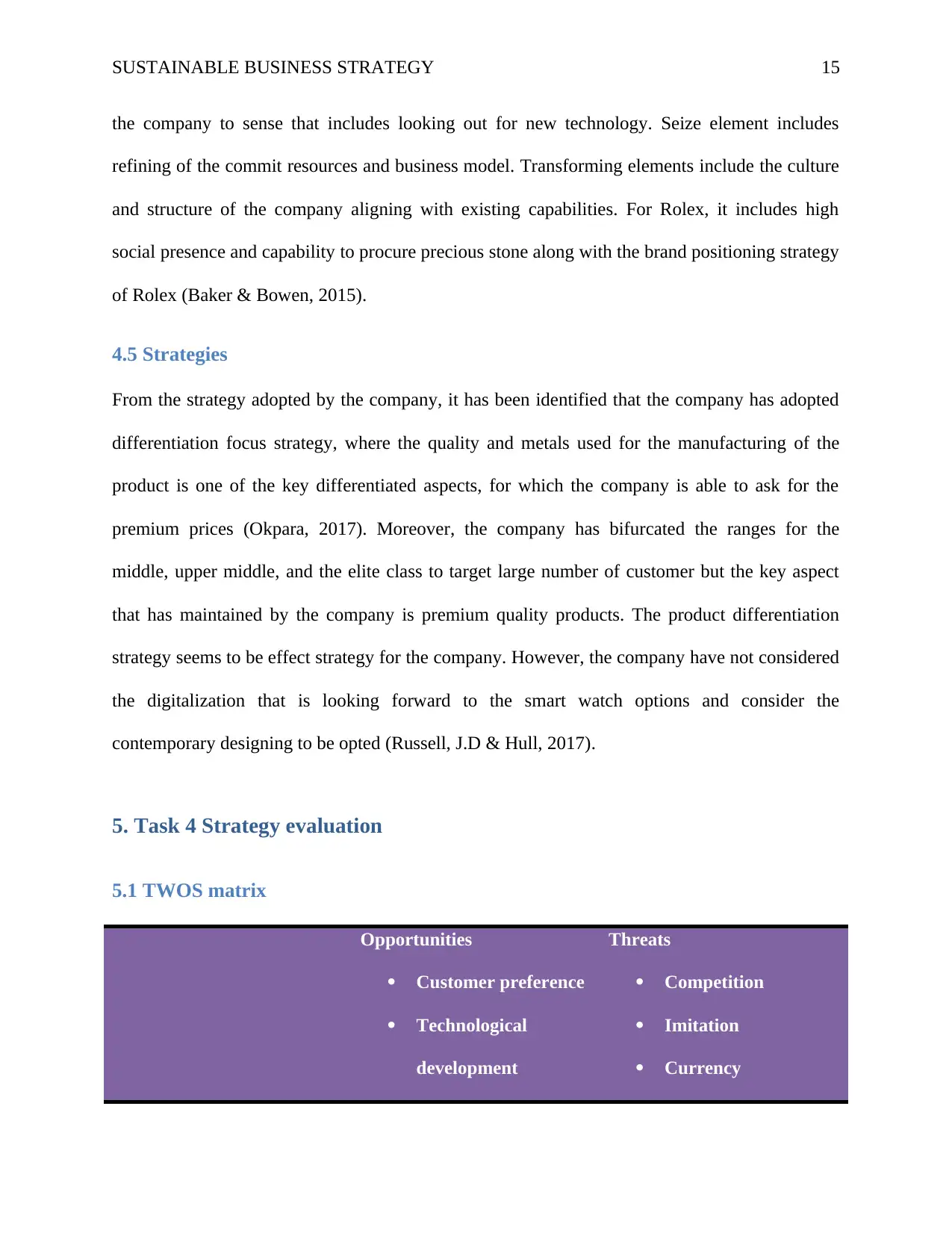
SUSTAINABLE BUSINESS STRATEGY 15
the company to sense that includes looking out for new technology. Seize element includes
refining of the commit resources and business model. Transforming elements include the culture
and structure of the company aligning with existing capabilities. For Rolex, it includes high
social presence and capability to procure precious stone along with the brand positioning strategy
of Rolex (Baker & Bowen, 2015).
4.5 Strategies
From the strategy adopted by the company, it has been identified that the company has adopted
differentiation focus strategy, where the quality and metals used for the manufacturing of the
product is one of the key differentiated aspects, for which the company is able to ask for the
premium prices (Okpara, 2017). Moreover, the company has bifurcated the ranges for the
middle, upper middle, and the elite class to target large number of customer but the key aspect
that has maintained by the company is premium quality products. The product differentiation
strategy seems to be effect strategy for the company. However, the company have not considered
the digitalization that is looking forward to the smart watch options and consider the
contemporary designing to be opted (Russell, J.D & Hull, 2017).
5. Task 4 Strategy evaluation
5.1 TWOS matrix
Opportunities
Customer preference
Technological
development
Threats
Competition
Imitation
Currency
the company to sense that includes looking out for new technology. Seize element includes
refining of the commit resources and business model. Transforming elements include the culture
and structure of the company aligning with existing capabilities. For Rolex, it includes high
social presence and capability to procure precious stone along with the brand positioning strategy
of Rolex (Baker & Bowen, 2015).
4.5 Strategies
From the strategy adopted by the company, it has been identified that the company has adopted
differentiation focus strategy, where the quality and metals used for the manufacturing of the
product is one of the key differentiated aspects, for which the company is able to ask for the
premium prices (Okpara, 2017). Moreover, the company has bifurcated the ranges for the
middle, upper middle, and the elite class to target large number of customer but the key aspect
that has maintained by the company is premium quality products. The product differentiation
strategy seems to be effect strategy for the company. However, the company have not considered
the digitalization that is looking forward to the smart watch options and consider the
contemporary designing to be opted (Russell, J.D & Hull, 2017).
5. Task 4 Strategy evaluation
5.1 TWOS matrix
Opportunities
Customer preference
Technological
development
Threats
Competition
Imitation
Currency
Secure Best Marks with AI Grader
Need help grading? Try our AI Grader for instant feedback on your assignments.
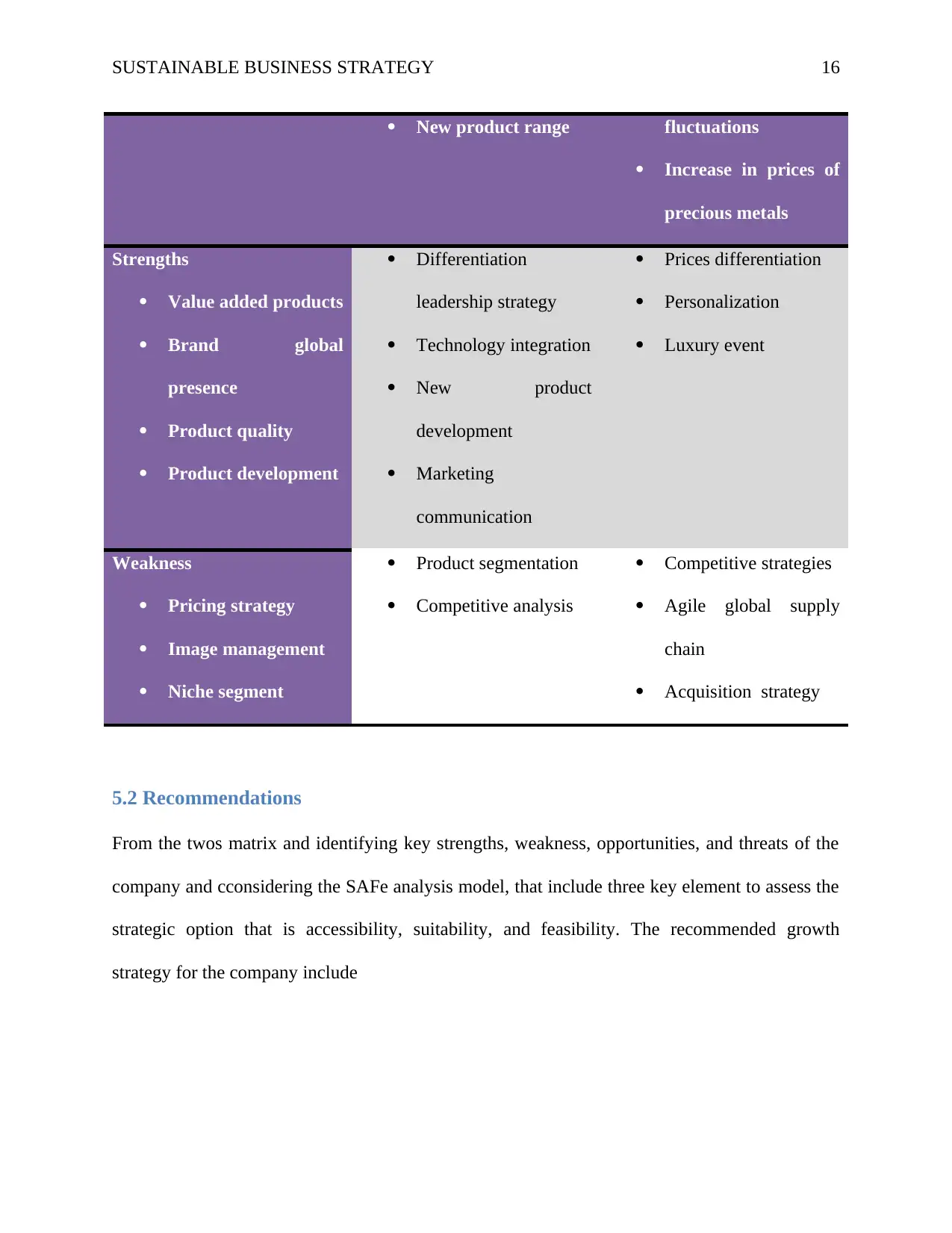
SUSTAINABLE BUSINESS STRATEGY 16
New product range fluctuations
Increase in prices of
precious metals
Strengths
Value added products
Brand global
presence
Product quality
Product development
Differentiation
leadership strategy
Technology integration
New product
development
Marketing
communication
Prices differentiation
Personalization
Luxury event
Weakness
Pricing strategy
Image management
Niche segment
Product segmentation
Competitive analysis
Competitive strategies
Agile global supply
chain
Acquisition strategy
5.2 Recommendations
From the twos matrix and identifying key strengths, weakness, opportunities, and threats of the
company and cconsidering the SAFe analysis model, that include three key element to assess the
strategic option that is accessibility, suitability, and feasibility. The recommended growth
strategy for the company include
New product range fluctuations
Increase in prices of
precious metals
Strengths
Value added products
Brand global
presence
Product quality
Product development
Differentiation
leadership strategy
Technology integration
New product
development
Marketing
communication
Prices differentiation
Personalization
Luxury event
Weakness
Pricing strategy
Image management
Niche segment
Product segmentation
Competitive analysis
Competitive strategies
Agile global supply
chain
Acquisition strategy
5.2 Recommendations
From the twos matrix and identifying key strengths, weakness, opportunities, and threats of the
company and cconsidering the SAFe analysis model, that include three key element to assess the
strategic option that is accessibility, suitability, and feasibility. The recommended growth
strategy for the company include
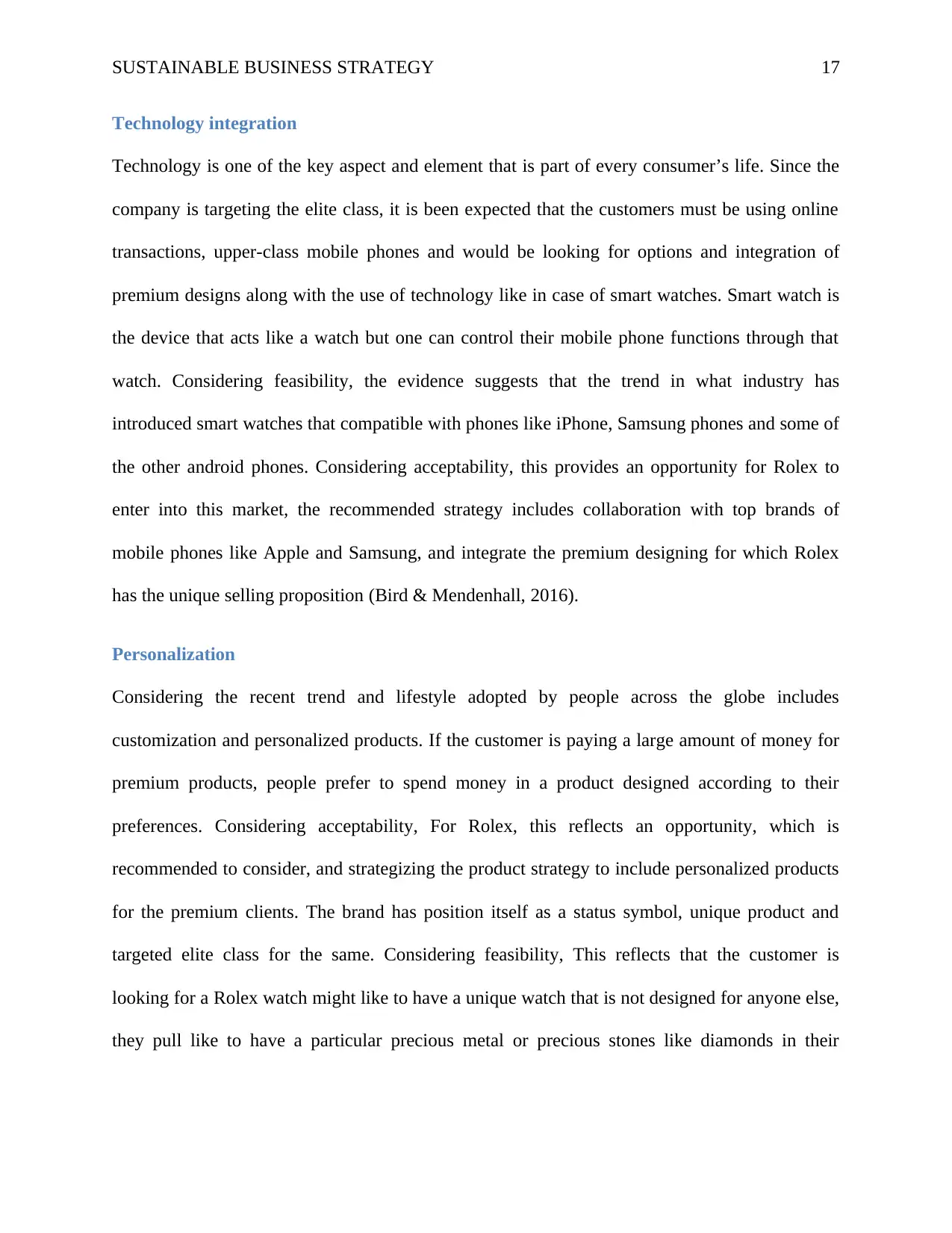
SUSTAINABLE BUSINESS STRATEGY 17
Technology integration
Technology is one of the key aspect and element that is part of every consumer’s life. Since the
company is targeting the elite class, it is been expected that the customers must be using online
transactions, upper-class mobile phones and would be looking for options and integration of
premium designs along with the use of technology like in case of smart watches. Smart watch is
the device that acts like a watch but one can control their mobile phone functions through that
watch. Considering feasibility, the evidence suggests that the trend in what industry has
introduced smart watches that compatible with phones like iPhone, Samsung phones and some of
the other android phones. Considering acceptability, this provides an opportunity for Rolex to
enter into this market, the recommended strategy includes collaboration with top brands of
mobile phones like Apple and Samsung, and integrate the premium designing for which Rolex
has the unique selling proposition (Bird & Mendenhall, 2016).
Personalization
Considering the recent trend and lifestyle adopted by people across the globe includes
customization and personalized products. If the customer is paying a large amount of money for
premium products, people prefer to spend money in a product designed according to their
preferences. Considering acceptability, For Rolex, this reflects an opportunity, which is
recommended to consider, and strategizing the product strategy to include personalized products
for the premium clients. The brand has position itself as a status symbol, unique product and
targeted elite class for the same. Considering feasibility, This reflects that the customer is
looking for a Rolex watch might like to have a unique watch that is not designed for anyone else,
they pull like to have a particular precious metal or precious stones like diamonds in their
Technology integration
Technology is one of the key aspect and element that is part of every consumer’s life. Since the
company is targeting the elite class, it is been expected that the customers must be using online
transactions, upper-class mobile phones and would be looking for options and integration of
premium designs along with the use of technology like in case of smart watches. Smart watch is
the device that acts like a watch but one can control their mobile phone functions through that
watch. Considering feasibility, the evidence suggests that the trend in what industry has
introduced smart watches that compatible with phones like iPhone, Samsung phones and some of
the other android phones. Considering acceptability, this provides an opportunity for Rolex to
enter into this market, the recommended strategy includes collaboration with top brands of
mobile phones like Apple and Samsung, and integrate the premium designing for which Rolex
has the unique selling proposition (Bird & Mendenhall, 2016).
Personalization
Considering the recent trend and lifestyle adopted by people across the globe includes
customization and personalized products. If the customer is paying a large amount of money for
premium products, people prefer to spend money in a product designed according to their
preferences. Considering acceptability, For Rolex, this reflects an opportunity, which is
recommended to consider, and strategizing the product strategy to include personalized products
for the premium clients. The brand has position itself as a status symbol, unique product and
targeted elite class for the same. Considering feasibility, This reflects that the customer is
looking for a Rolex watch might like to have a unique watch that is not designed for anyone else,
they pull like to have a particular precious metal or precious stones like diamonds in their
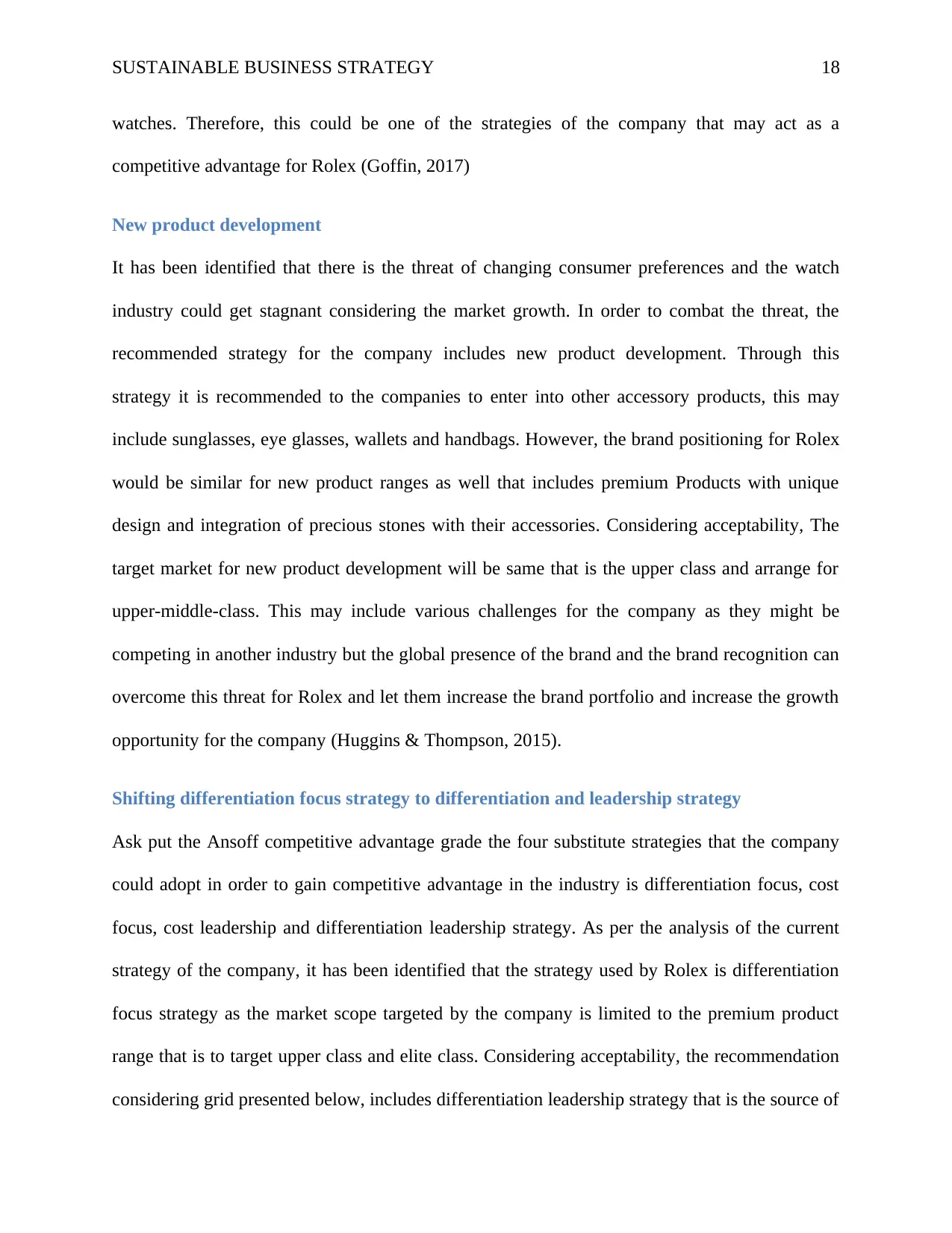
SUSTAINABLE BUSINESS STRATEGY 18
watches. Therefore, this could be one of the strategies of the company that may act as a
competitive advantage for Rolex (Goffin, 2017)
New product development
It has been identified that there is the threat of changing consumer preferences and the watch
industry could get stagnant considering the market growth. In order to combat the threat, the
recommended strategy for the company includes new product development. Through this
strategy it is recommended to the companies to enter into other accessory products, this may
include sunglasses, eye glasses, wallets and handbags. However, the brand positioning for Rolex
would be similar for new product ranges as well that includes premium Products with unique
design and integration of precious stones with their accessories. Considering acceptability, The
target market for new product development will be same that is the upper class and arrange for
upper-middle-class. This may include various challenges for the company as they might be
competing in another industry but the global presence of the brand and the brand recognition can
overcome this threat for Rolex and let them increase the brand portfolio and increase the growth
opportunity for the company (Huggins & Thompson, 2015).
Shifting differentiation focus strategy to differentiation and leadership strategy
Ask put the Ansoff competitive advantage grade the four substitute strategies that the company
could adopt in order to gain competitive advantage in the industry is differentiation focus, cost
focus, cost leadership and differentiation leadership strategy. As per the analysis of the current
strategy of the company, it has been identified that the strategy used by Rolex is differentiation
focus strategy as the market scope targeted by the company is limited to the premium product
range that is to target upper class and elite class. Considering acceptability, the recommendation
considering grid presented below, includes differentiation leadership strategy that is the source of
watches. Therefore, this could be one of the strategies of the company that may act as a
competitive advantage for Rolex (Goffin, 2017)
New product development
It has been identified that there is the threat of changing consumer preferences and the watch
industry could get stagnant considering the market growth. In order to combat the threat, the
recommended strategy for the company includes new product development. Through this
strategy it is recommended to the companies to enter into other accessory products, this may
include sunglasses, eye glasses, wallets and handbags. However, the brand positioning for Rolex
would be similar for new product ranges as well that includes premium Products with unique
design and integration of precious stones with their accessories. Considering acceptability, The
target market for new product development will be same that is the upper class and arrange for
upper-middle-class. This may include various challenges for the company as they might be
competing in another industry but the global presence of the brand and the brand recognition can
overcome this threat for Rolex and let them increase the brand portfolio and increase the growth
opportunity for the company (Huggins & Thompson, 2015).
Shifting differentiation focus strategy to differentiation and leadership strategy
Ask put the Ansoff competitive advantage grade the four substitute strategies that the company
could adopt in order to gain competitive advantage in the industry is differentiation focus, cost
focus, cost leadership and differentiation leadership strategy. As per the analysis of the current
strategy of the company, it has been identified that the strategy used by Rolex is differentiation
focus strategy as the market scope targeted by the company is limited to the premium product
range that is to target upper class and elite class. Considering acceptability, the recommendation
considering grid presented below, includes differentiation leadership strategy that is the source of
Paraphrase This Document
Need a fresh take? Get an instant paraphrase of this document with our AI Paraphraser
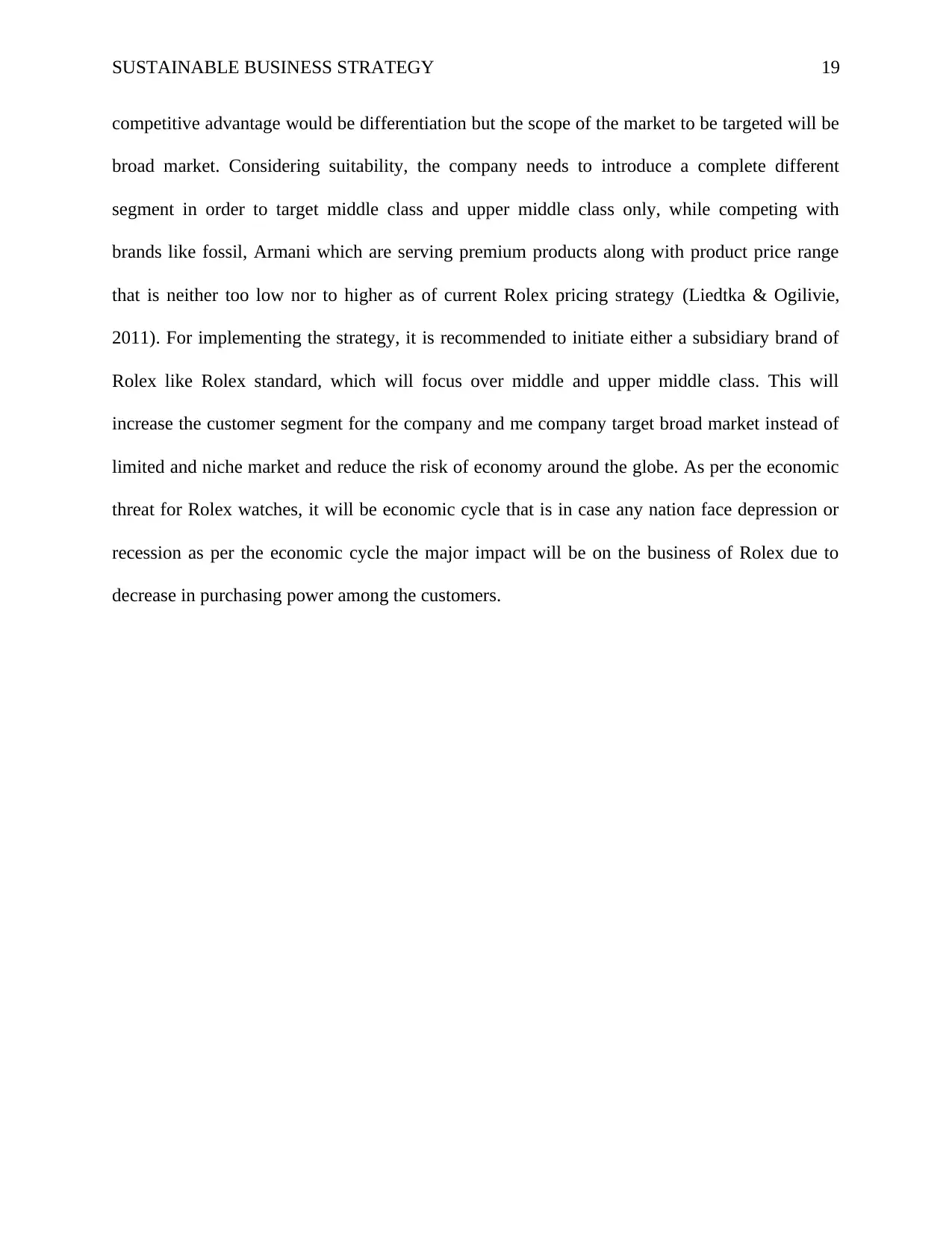
SUSTAINABLE BUSINESS STRATEGY 19
competitive advantage would be differentiation but the scope of the market to be targeted will be
broad market. Considering suitability, the company needs to introduce a complete different
segment in order to target middle class and upper middle class only, while competing with
brands like fossil, Armani which are serving premium products along with product price range
that is neither too low nor to higher as of current Rolex pricing strategy (Liedtka & Ogilivie,
2011). For implementing the strategy, it is recommended to initiate either a subsidiary brand of
Rolex like Rolex standard, which will focus over middle and upper middle class. This will
increase the customer segment for the company and me company target broad market instead of
limited and niche market and reduce the risk of economy around the globe. As per the economic
threat for Rolex watches, it will be economic cycle that is in case any nation face depression or
recession as per the economic cycle the major impact will be on the business of Rolex due to
decrease in purchasing power among the customers.
competitive advantage would be differentiation but the scope of the market to be targeted will be
broad market. Considering suitability, the company needs to introduce a complete different
segment in order to target middle class and upper middle class only, while competing with
brands like fossil, Armani which are serving premium products along with product price range
that is neither too low nor to higher as of current Rolex pricing strategy (Liedtka & Ogilivie,
2011). For implementing the strategy, it is recommended to initiate either a subsidiary brand of
Rolex like Rolex standard, which will focus over middle and upper middle class. This will
increase the customer segment for the company and me company target broad market instead of
limited and niche market and reduce the risk of economy around the globe. As per the economic
threat for Rolex watches, it will be economic cycle that is in case any nation face depression or
recession as per the economic cycle the major impact will be on the business of Rolex due to
decrease in purchasing power among the customers.
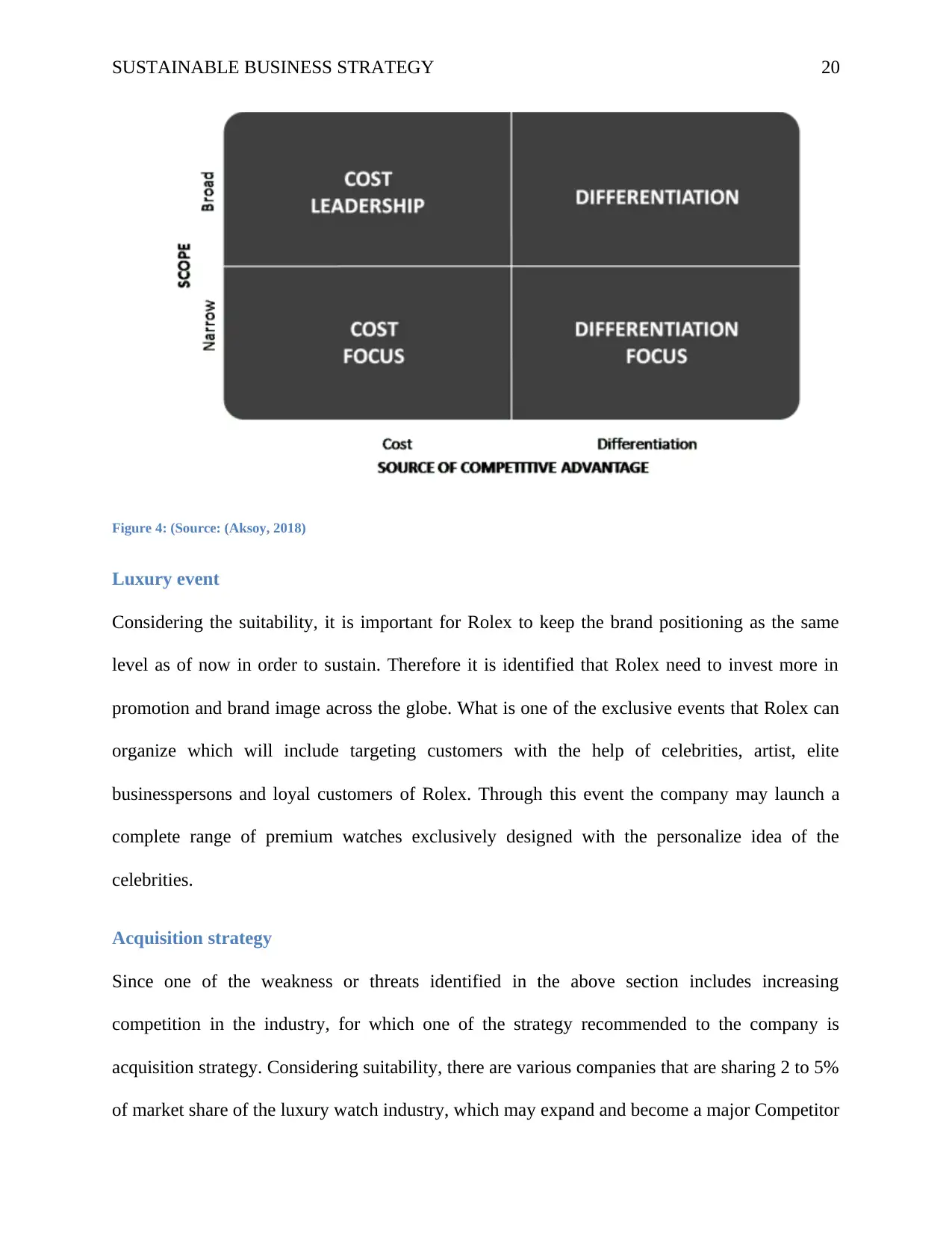
SUSTAINABLE BUSINESS STRATEGY 20
Figure 4: (Source: (Aksoy, 2018)
Luxury event
Considering the suitability, it is important for Rolex to keep the brand positioning as the same
level as of now in order to sustain. Therefore it is identified that Rolex need to invest more in
promotion and brand image across the globe. What is one of the exclusive events that Rolex can
organize which will include targeting customers with the help of celebrities, artist, elite
businesspersons and loyal customers of Rolex. Through this event the company may launch a
complete range of premium watches exclusively designed with the personalize idea of the
celebrities.
Acquisition strategy
Since one of the weakness or threats identified in the above section includes increasing
competition in the industry, for which one of the strategy recommended to the company is
acquisition strategy. Considering suitability, there are various companies that are sharing 2 to 5%
of market share of the luxury watch industry, which may expand and become a major Competitor
Figure 4: (Source: (Aksoy, 2018)
Luxury event
Considering the suitability, it is important for Rolex to keep the brand positioning as the same
level as of now in order to sustain. Therefore it is identified that Rolex need to invest more in
promotion and brand image across the globe. What is one of the exclusive events that Rolex can
organize which will include targeting customers with the help of celebrities, artist, elite
businesspersons and loyal customers of Rolex. Through this event the company may launch a
complete range of premium watches exclusively designed with the personalize idea of the
celebrities.
Acquisition strategy
Since one of the weakness or threats identified in the above section includes increasing
competition in the industry, for which one of the strategy recommended to the company is
acquisition strategy. Considering suitability, there are various companies that are sharing 2 to 5%
of market share of the luxury watch industry, which may expand and become a major Competitor
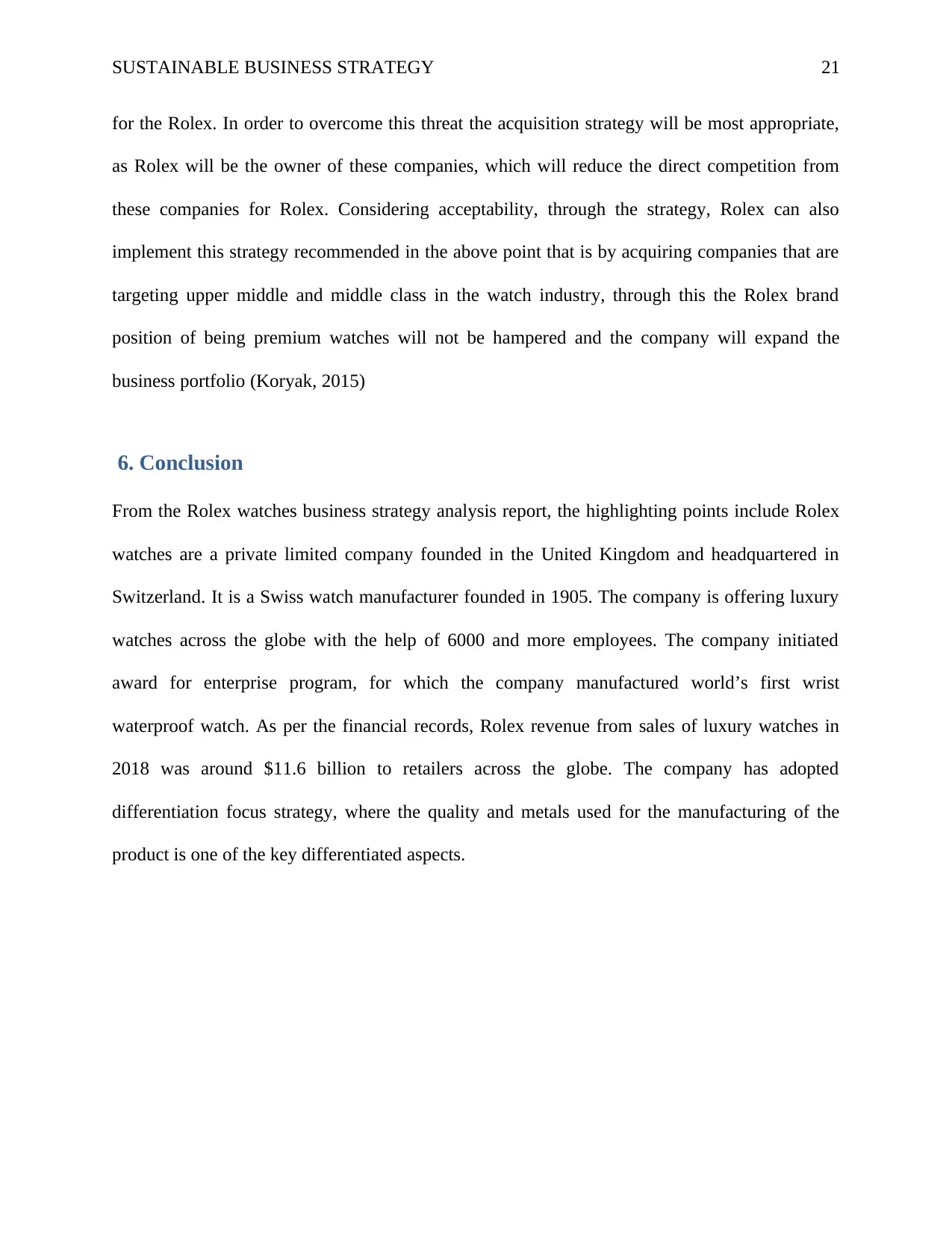
SUSTAINABLE BUSINESS STRATEGY 21
for the Rolex. In order to overcome this threat the acquisition strategy will be most appropriate,
as Rolex will be the owner of these companies, which will reduce the direct competition from
these companies for Rolex. Considering acceptability, through the strategy, Rolex can also
implement this strategy recommended in the above point that is by acquiring companies that are
targeting upper middle and middle class in the watch industry, through this the Rolex brand
position of being premium watches will not be hampered and the company will expand the
business portfolio (Koryak, 2015)
6. Conclusion
From the Rolex watches business strategy analysis report, the highlighting points include Rolex
watches are a private limited company founded in the United Kingdom and headquartered in
Switzerland. It is a Swiss watch manufacturer founded in 1905. The company is offering luxury
watches across the globe with the help of 6000 and more employees. The company initiated
award for enterprise program, for which the company manufactured world’s first wrist
waterproof watch. As per the financial records, Rolex revenue from sales of luxury watches in
2018 was around $11.6 billion to retailers across the globe. The company has adopted
differentiation focus strategy, where the quality and metals used for the manufacturing of the
product is one of the key differentiated aspects.
for the Rolex. In order to overcome this threat the acquisition strategy will be most appropriate,
as Rolex will be the owner of these companies, which will reduce the direct competition from
these companies for Rolex. Considering acceptability, through the strategy, Rolex can also
implement this strategy recommended in the above point that is by acquiring companies that are
targeting upper middle and middle class in the watch industry, through this the Rolex brand
position of being premium watches will not be hampered and the company will expand the
business portfolio (Koryak, 2015)
6. Conclusion
From the Rolex watches business strategy analysis report, the highlighting points include Rolex
watches are a private limited company founded in the United Kingdom and headquartered in
Switzerland. It is a Swiss watch manufacturer founded in 1905. The company is offering luxury
watches across the globe with the help of 6000 and more employees. The company initiated
award for enterprise program, for which the company manufactured world’s first wrist
waterproof watch. As per the financial records, Rolex revenue from sales of luxury watches in
2018 was around $11.6 billion to retailers across the globe. The company has adopted
differentiation focus strategy, where the quality and metals used for the manufacturing of the
product is one of the key differentiated aspects.
Secure Best Marks with AI Grader
Need help grading? Try our AI Grader for instant feedback on your assignments.
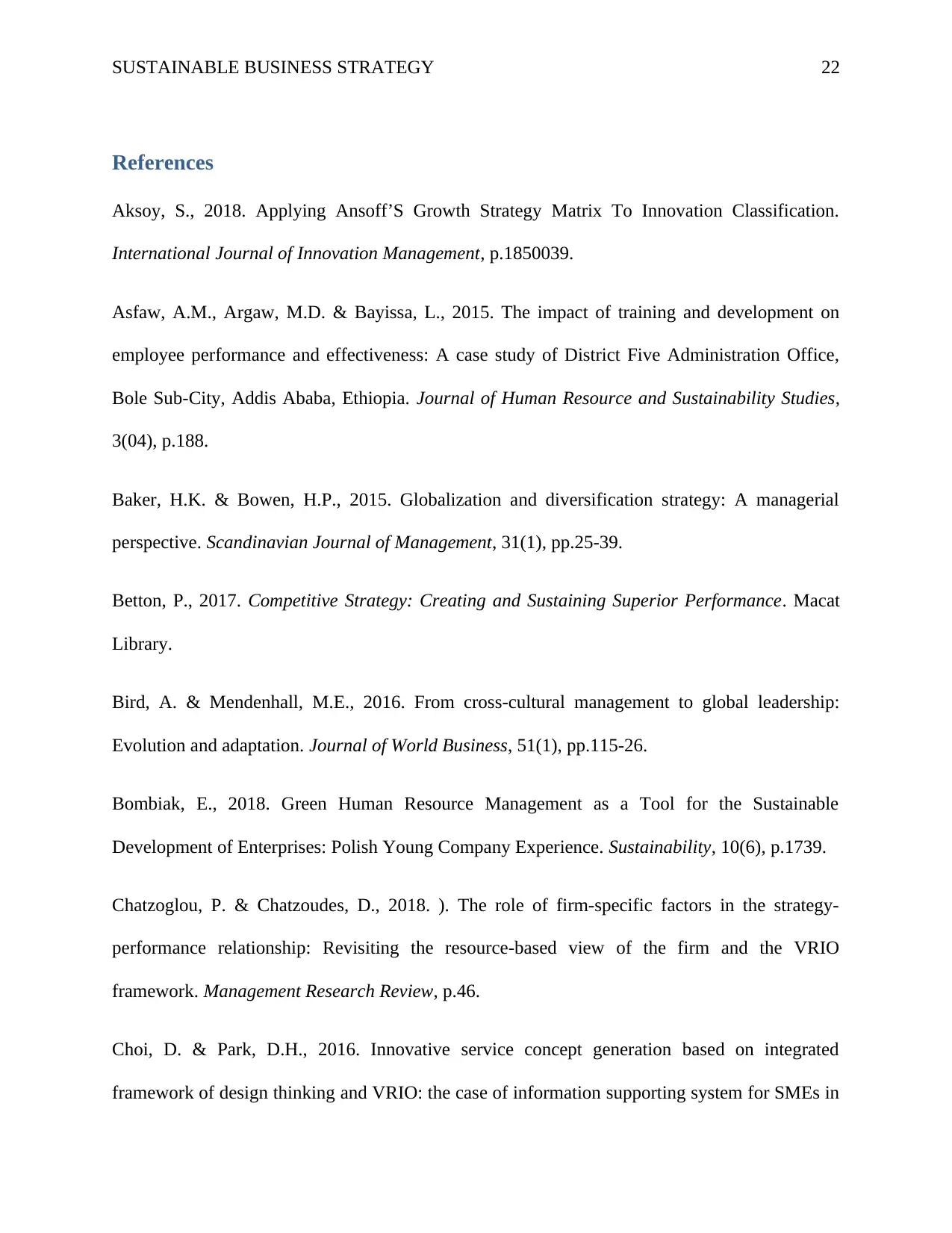
SUSTAINABLE BUSINESS STRATEGY 22
References
Aksoy, S., 2018. Applying Ansoff’S Growth Strategy Matrix To Innovation Classification.
International Journal of Innovation Management, p.1850039.
Asfaw, A.M., Argaw, M.D. & Bayissa, L., 2015. The impact of training and development on
employee performance and effectiveness: A case study of District Five Administration Office,
Bole Sub-City, Addis Ababa, Ethiopia. Journal of Human Resource and Sustainability Studies,
3(04), p.188.
Baker, H.K. & Bowen, H.P., 2015. Globalization and diversification strategy: A managerial
perspective. Scandinavian Journal of Management, 31(1), pp.25-39.
Betton, P., 2017. Competitive Strategy: Creating and Sustaining Superior Performance. Macat
Library.
Bird, A. & Mendenhall, M.E., 2016. From cross-cultural management to global leadership:
Evolution and adaptation. Journal of World Business, 51(1), pp.115-26.
Bombiak, E., 2018. Green Human Resource Management as a Tool for the Sustainable
Development of Enterprises: Polish Young Company Experience. Sustainability, 10(6), p.1739.
Chatzoglou, P. & Chatzoudes, D., 2018. ). The role of firm-specific factors in the strategy-
performance relationship: Revisiting the resource-based view of the firm and the VRIO
framework. Management Research Review, p.46.
Choi, D. & Park, D.H., 2016. Innovative service concept generation based on integrated
framework of design thinking and VRIO: the case of information supporting system for SMEs in
References
Aksoy, S., 2018. Applying Ansoff’S Growth Strategy Matrix To Innovation Classification.
International Journal of Innovation Management, p.1850039.
Asfaw, A.M., Argaw, M.D. & Bayissa, L., 2015. The impact of training and development on
employee performance and effectiveness: A case study of District Five Administration Office,
Bole Sub-City, Addis Ababa, Ethiopia. Journal of Human Resource and Sustainability Studies,
3(04), p.188.
Baker, H.K. & Bowen, H.P., 2015. Globalization and diversification strategy: A managerial
perspective. Scandinavian Journal of Management, 31(1), pp.25-39.
Betton, P., 2017. Competitive Strategy: Creating and Sustaining Superior Performance. Macat
Library.
Bird, A. & Mendenhall, M.E., 2016. From cross-cultural management to global leadership:
Evolution and adaptation. Journal of World Business, 51(1), pp.115-26.
Bombiak, E., 2018. Green Human Resource Management as a Tool for the Sustainable
Development of Enterprises: Polish Young Company Experience. Sustainability, 10(6), p.1739.
Chatzoglou, P. & Chatzoudes, D., 2018. ). The role of firm-specific factors in the strategy-
performance relationship: Revisiting the resource-based view of the firm and the VRIO
framework. Management Research Review, p.46.
Choi, D. & Park, D.H., 2016. Innovative service concept generation based on integrated
framework of design thinking and VRIO: the case of information supporting system for SMEs in
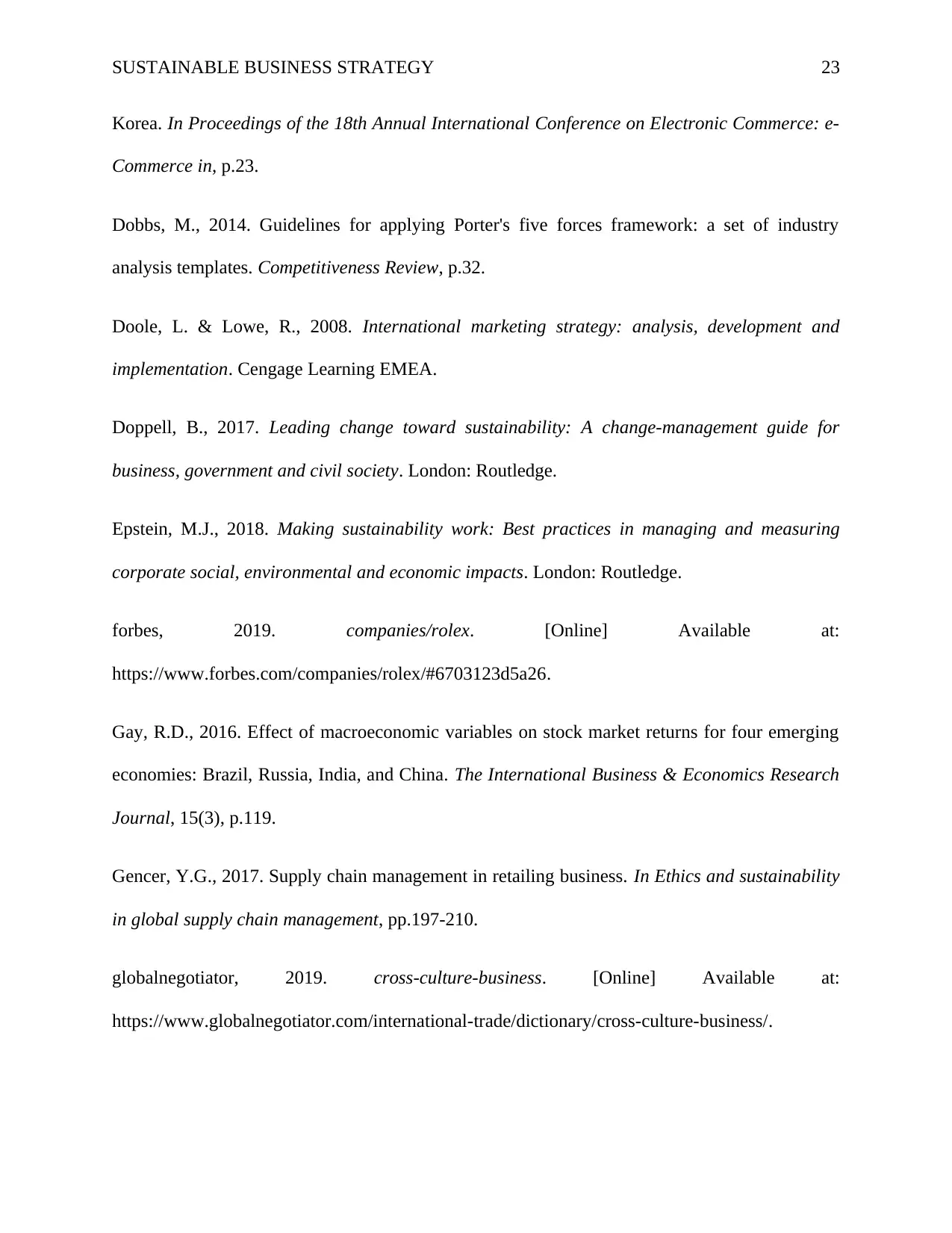
SUSTAINABLE BUSINESS STRATEGY 23
Korea. In Proceedings of the 18th Annual International Conference on Electronic Commerce: e-
Commerce in, p.23.
Dobbs, M., 2014. Guidelines for applying Porter's five forces framework: a set of industry
analysis templates. Competitiveness Review, p.32.
Doole, L. & Lowe, R., 2008. International marketing strategy: analysis, development and
implementation. Cengage Learning EMEA.
Doppell, B., 2017. Leading change toward sustainability: A change-management guide for
business, government and civil society. London: Routledge.
Epstein, M.J., 2018. Making sustainability work: Best practices in managing and measuring
corporate social, environmental and economic impacts. London: Routledge.
forbes, 2019. companies/rolex. [Online] Available at:
https://www.forbes.com/companies/rolex/#6703123d5a26.
Gay, R.D., 2016. Effect of macroeconomic variables on stock market returns for four emerging
economies: Brazil, Russia, India, and China. The International Business & Economics Research
Journal, 15(3), p.119.
Gencer, Y.G., 2017. Supply chain management in retailing business. In Ethics and sustainability
in global supply chain management, pp.197-210.
globalnegotiator, 2019. cross-culture-business. [Online] Available at:
https://www.globalnegotiator.com/international-trade/dictionary/cross-culture-business/.
Korea. In Proceedings of the 18th Annual International Conference on Electronic Commerce: e-
Commerce in, p.23.
Dobbs, M., 2014. Guidelines for applying Porter's five forces framework: a set of industry
analysis templates. Competitiveness Review, p.32.
Doole, L. & Lowe, R., 2008. International marketing strategy: analysis, development and
implementation. Cengage Learning EMEA.
Doppell, B., 2017. Leading change toward sustainability: A change-management guide for
business, government and civil society. London: Routledge.
Epstein, M.J., 2018. Making sustainability work: Best practices in managing and measuring
corporate social, environmental and economic impacts. London: Routledge.
forbes, 2019. companies/rolex. [Online] Available at:
https://www.forbes.com/companies/rolex/#6703123d5a26.
Gay, R.D., 2016. Effect of macroeconomic variables on stock market returns for four emerging
economies: Brazil, Russia, India, and China. The International Business & Economics Research
Journal, 15(3), p.119.
Gencer, Y.G., 2017. Supply chain management in retailing business. In Ethics and sustainability
in global supply chain management, pp.197-210.
globalnegotiator, 2019. cross-culture-business. [Online] Available at:
https://www.globalnegotiator.com/international-trade/dictionary/cross-culture-business/.
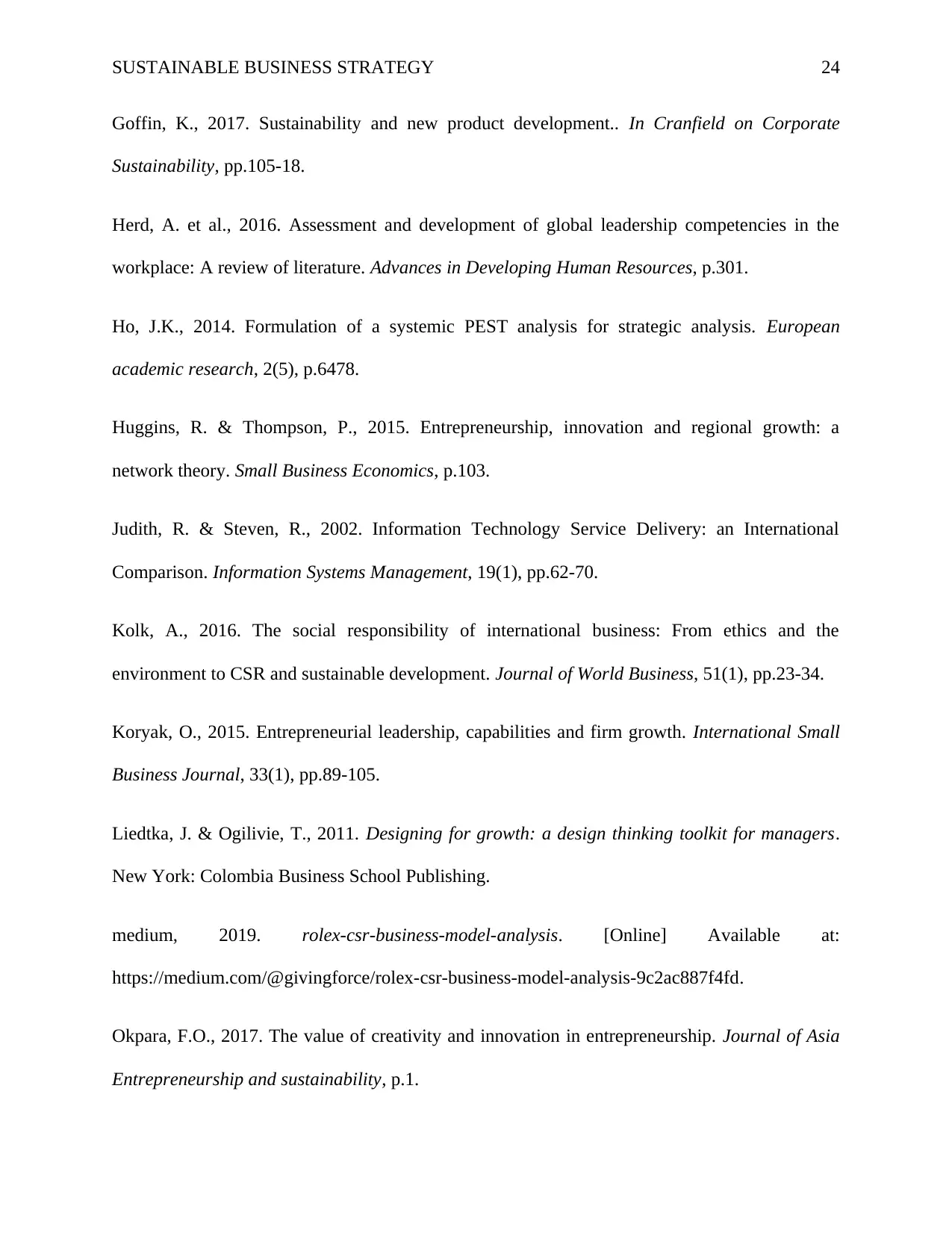
SUSTAINABLE BUSINESS STRATEGY 24
Goffin, K., 2017. Sustainability and new product development.. In Cranfield on Corporate
Sustainability, pp.105-18.
Herd, A. et al., 2016. Assessment and development of global leadership competencies in the
workplace: A review of literature. Advances in Developing Human Resources, p.301.
Ho, J.K., 2014. Formulation of a systemic PEST analysis for strategic analysis. European
academic research, 2(5), p.6478.
Huggins, R. & Thompson, P., 2015. Entrepreneurship, innovation and regional growth: a
network theory. Small Business Economics, p.103.
Judith, R. & Steven, R., 2002. Information Technology Service Delivery: an International
Comparison. Information Systems Management, 19(1), pp.62-70.
Kolk, A., 2016. The social responsibility of international business: From ethics and the
environment to CSR and sustainable development. Journal of World Business, 51(1), pp.23-34.
Koryak, O., 2015. Entrepreneurial leadership, capabilities and firm growth. International Small
Business Journal, 33(1), pp.89-105.
Liedtka, J. & Ogilivie, T., 2011. Designing for growth: a design thinking toolkit for managers.
New York: Colombia Business School Publishing.
medium, 2019. rolex-csr-business-model-analysis. [Online] Available at:
https://medium.com/@givingforce/rolex-csr-business-model-analysis-9c2ac887f4fd.
Okpara, F.O., 2017. The value of creativity and innovation in entrepreneurship. Journal of Asia
Entrepreneurship and sustainability, p.1.
Goffin, K., 2017. Sustainability and new product development.. In Cranfield on Corporate
Sustainability, pp.105-18.
Herd, A. et al., 2016. Assessment and development of global leadership competencies in the
workplace: A review of literature. Advances in Developing Human Resources, p.301.
Ho, J.K., 2014. Formulation of a systemic PEST analysis for strategic analysis. European
academic research, 2(5), p.6478.
Huggins, R. & Thompson, P., 2015. Entrepreneurship, innovation and regional growth: a
network theory. Small Business Economics, p.103.
Judith, R. & Steven, R., 2002. Information Technology Service Delivery: an International
Comparison. Information Systems Management, 19(1), pp.62-70.
Kolk, A., 2016. The social responsibility of international business: From ethics and the
environment to CSR and sustainable development. Journal of World Business, 51(1), pp.23-34.
Koryak, O., 2015. Entrepreneurial leadership, capabilities and firm growth. International Small
Business Journal, 33(1), pp.89-105.
Liedtka, J. & Ogilivie, T., 2011. Designing for growth: a design thinking toolkit for managers.
New York: Colombia Business School Publishing.
medium, 2019. rolex-csr-business-model-analysis. [Online] Available at:
https://medium.com/@givingforce/rolex-csr-business-model-analysis-9c2ac887f4fd.
Okpara, F.O., 2017. The value of creativity and innovation in entrepreneurship. Journal of Asia
Entrepreneurship and sustainability, p.1.
Paraphrase This Document
Need a fresh take? Get an instant paraphrase of this document with our AI Paraphraser
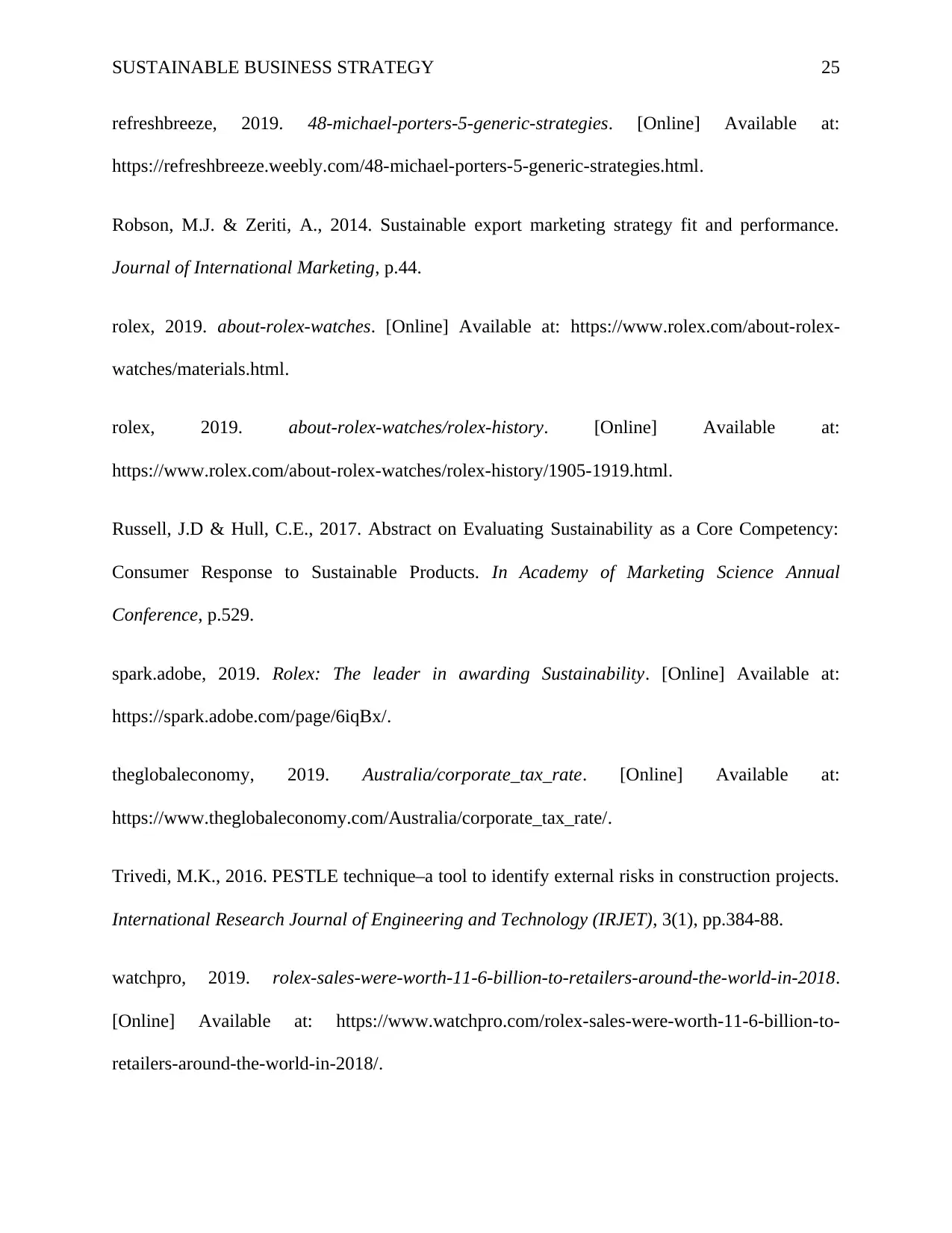
SUSTAINABLE BUSINESS STRATEGY 25
refreshbreeze, 2019. 48-michael-porters-5-generic-strategies. [Online] Available at:
https://refreshbreeze.weebly.com/48-michael-porters-5-generic-strategies.html.
Robson, M.J. & Zeriti, A., 2014. Sustainable export marketing strategy fit and performance.
Journal of International Marketing, p.44.
rolex, 2019. about-rolex-watches. [Online] Available at: https://www.rolex.com/about-rolex-
watches/materials.html.
rolex, 2019. about-rolex-watches/rolex-history. [Online] Available at:
https://www.rolex.com/about-rolex-watches/rolex-history/1905-1919.html.
Russell, J.D & Hull, C.E., 2017. Abstract on Evaluating Sustainability as a Core Competency:
Consumer Response to Sustainable Products. In Academy of Marketing Science Annual
Conference, p.529.
spark.adobe, 2019. Rolex: The leader in awarding Sustainability. [Online] Available at:
https://spark.adobe.com/page/6iqBx/.
theglobaleconomy, 2019. Australia/corporate_tax_rate. [Online] Available at:
https://www.theglobaleconomy.com/Australia/corporate_tax_rate/.
Trivedi, M.K., 2016. PESTLE technique–a tool to identify external risks in construction projects.
International Research Journal of Engineering and Technology (IRJET), 3(1), pp.384-88.
watchpro, 2019. rolex-sales-were-worth-11-6-billion-to-retailers-around-the-world-in-2018.
[Online] Available at: https://www.watchpro.com/rolex-sales-were-worth-11-6-billion-to-
retailers-around-the-world-in-2018/.
refreshbreeze, 2019. 48-michael-porters-5-generic-strategies. [Online] Available at:
https://refreshbreeze.weebly.com/48-michael-porters-5-generic-strategies.html.
Robson, M.J. & Zeriti, A., 2014. Sustainable export marketing strategy fit and performance.
Journal of International Marketing, p.44.
rolex, 2019. about-rolex-watches. [Online] Available at: https://www.rolex.com/about-rolex-
watches/materials.html.
rolex, 2019. about-rolex-watches/rolex-history. [Online] Available at:
https://www.rolex.com/about-rolex-watches/rolex-history/1905-1919.html.
Russell, J.D & Hull, C.E., 2017. Abstract on Evaluating Sustainability as a Core Competency:
Consumer Response to Sustainable Products. In Academy of Marketing Science Annual
Conference, p.529.
spark.adobe, 2019. Rolex: The leader in awarding Sustainability. [Online] Available at:
https://spark.adobe.com/page/6iqBx/.
theglobaleconomy, 2019. Australia/corporate_tax_rate. [Online] Available at:
https://www.theglobaleconomy.com/Australia/corporate_tax_rate/.
Trivedi, M.K., 2016. PESTLE technique–a tool to identify external risks in construction projects.
International Research Journal of Engineering and Technology (IRJET), 3(1), pp.384-88.
watchpro, 2019. rolex-sales-were-worth-11-6-billion-to-retailers-around-the-world-in-2018.
[Online] Available at: https://www.watchpro.com/rolex-sales-were-worth-11-6-billion-to-
retailers-around-the-world-in-2018/.
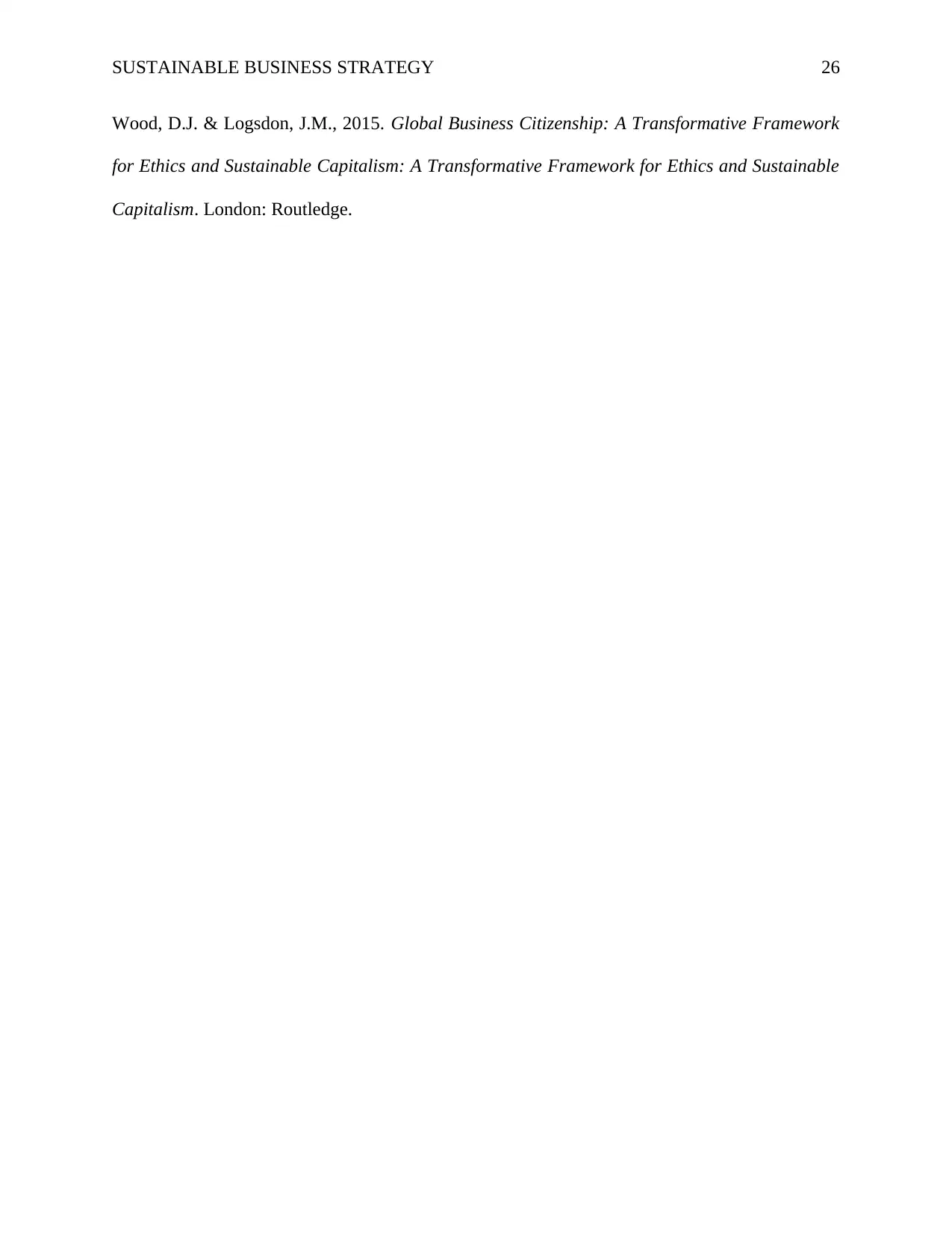
SUSTAINABLE BUSINESS STRATEGY 26
Wood, D.J. & Logsdon, J.M., 2015. Global Business Citizenship: A Transformative Framework
for Ethics and Sustainable Capitalism: A Transformative Framework for Ethics and Sustainable
Capitalism. London: Routledge.
Wood, D.J. & Logsdon, J.M., 2015. Global Business Citizenship: A Transformative Framework
for Ethics and Sustainable Capitalism: A Transformative Framework for Ethics and Sustainable
Capitalism. London: Routledge.
1 out of 27
Related Documents
Your All-in-One AI-Powered Toolkit for Academic Success.
+13062052269
info@desklib.com
Available 24*7 on WhatsApp / Email
![[object Object]](/_next/static/media/star-bottom.7253800d.svg)
Unlock your academic potential
© 2024 | Zucol Services PVT LTD | All rights reserved.





